Install Steam
login
|
language
简体中文 (Simplified Chinese)
繁體中文 (Traditional Chinese)
日本語 (Japanese)
한국어 (Korean)
ไทย (Thai)
Български (Bulgarian)
Čeština (Czech)
Dansk (Danish)
Deutsch (German)
Español - España (Spanish - Spain)
Español - Latinoamérica (Spanish - Latin America)
Ελληνικά (Greek)
Français (French)
Italiano (Italian)
Bahasa Indonesia (Indonesian)
Magyar (Hungarian)
Nederlands (Dutch)
Norsk (Norwegian)
Polski (Polish)
Português (Portuguese - Portugal)
Português - Brasil (Portuguese - Brazil)
Română (Romanian)
Русский (Russian)
Suomi (Finnish)
Svenska (Swedish)
Türkçe (Turkish)
Tiếng Việt (Vietnamese)
Українська (Ukrainian)
Report a translation problem







 The Philippines gained their independence from Spain in 1898 following a War of Independence led by Andrés Bonifacio and later Emilio Aguinaldo. This effectively merged into the Spanish-American war through an American intervention in the archipelago. The resultant Treaty of Paris awarded the Philippines to the United States. The revolutionaries struggled on against their new overlords, but were eventually defeated in 1902 and the Philippines became an American colony.
The Philippines gained their independence from Spain in 1898 following a War of Independence led by Andrés Bonifacio and later Emilio Aguinaldo. This effectively merged into the Spanish-American war through an American intervention in the archipelago. The resultant Treaty of Paris awarded the Philippines to the United States. The revolutionaries struggled on against their new overlords, but were eventually defeated in 1902 and the Philippines became an American colony.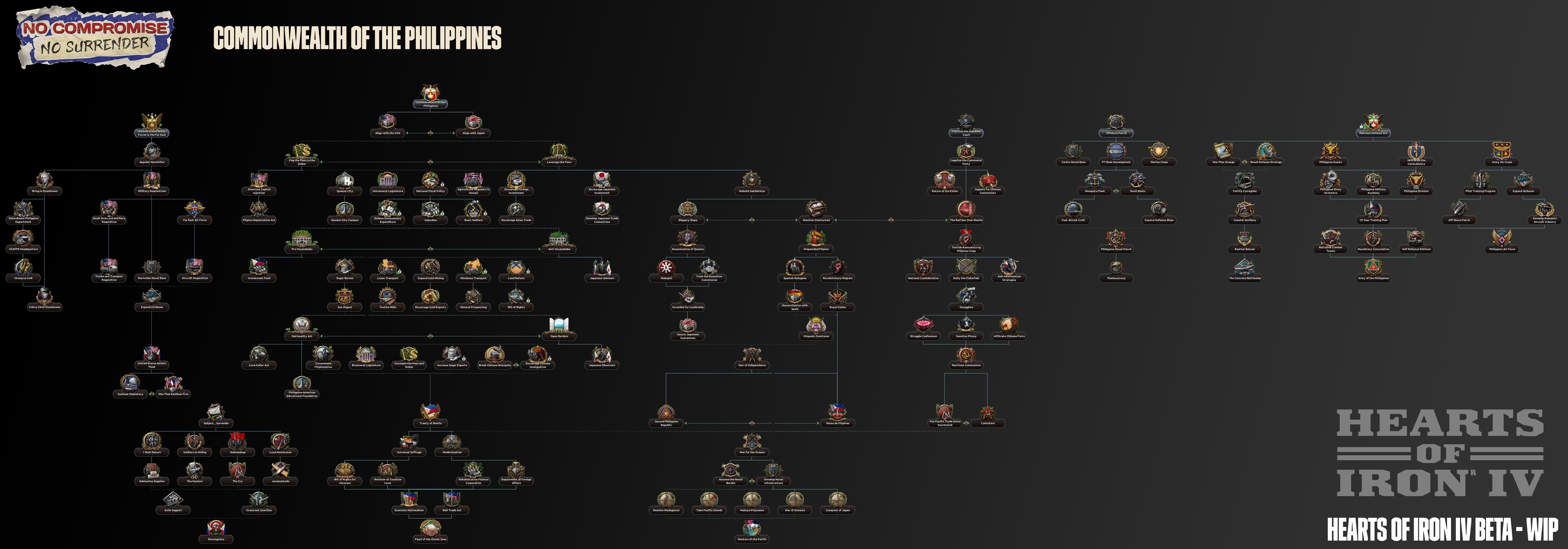
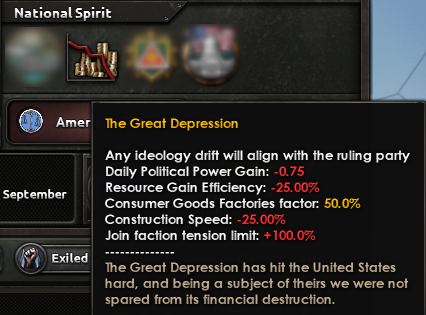 Yikes, that’s crippling! Yes, it is, but there are solutions to this problem.
Yikes, that’s crippling! Yes, it is, but there are solutions to this problem.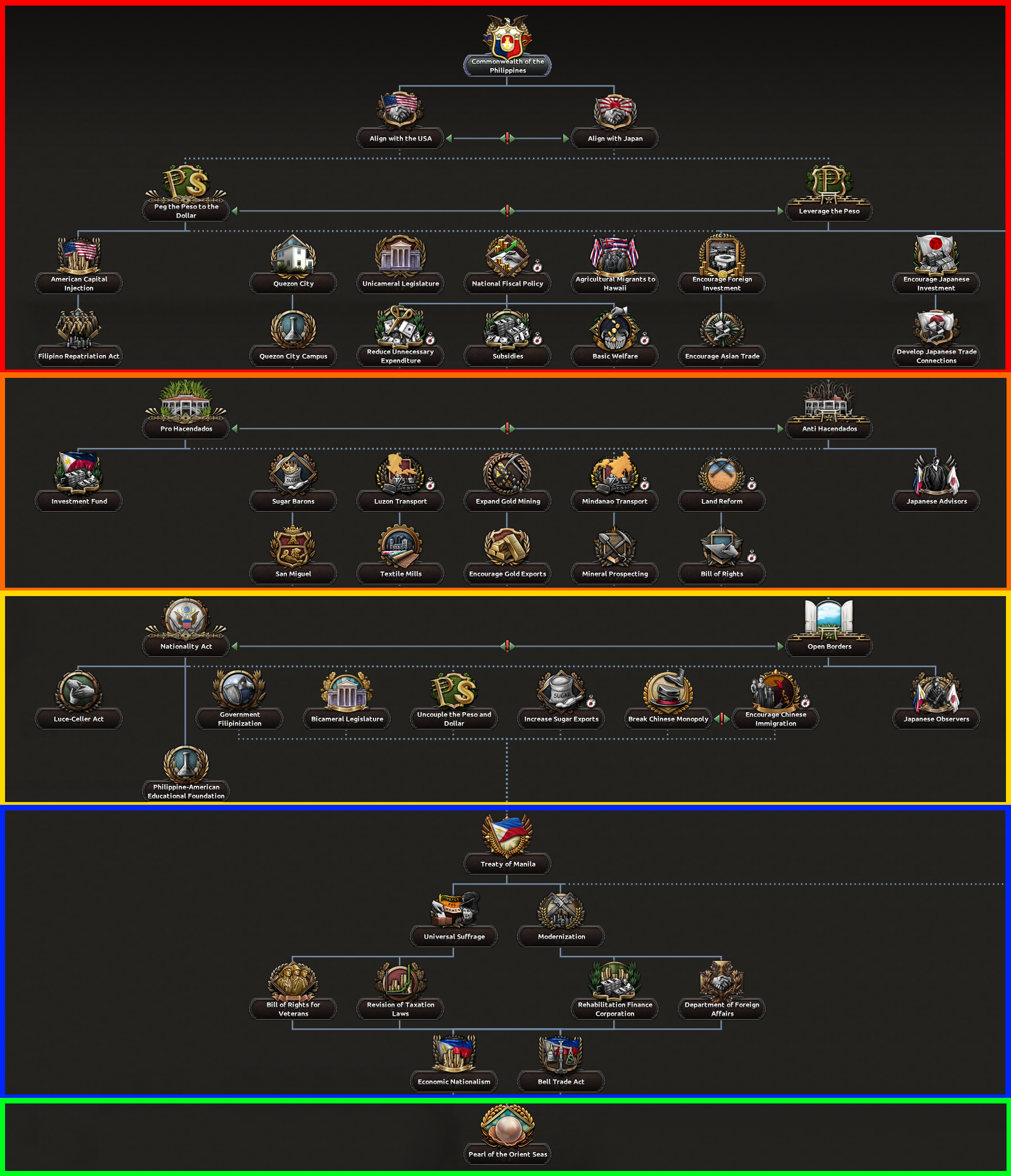 Introducing the economic tree, roughly divided into 5 tiers;
Introducing the economic tree, roughly divided into 5 tiers;  Once you’ve aligned yourself with one side or the other, you’re free to start actually altering your economy. You do this by progressing through the aforementioned tiers. Within each tier, you have the central, generic economic and political choices available to all paths (the red square). You need to take 5 of these in order to complete the tier, and thereby gain access to the “milestone” (in green). You will also have some special benefits depending on whether you previously went on the left side or the right side (in blue), these usually pertain to either the USA or Japan, but these do not count towards the completion of a tier.
Once you’ve aligned yourself with one side or the other, you’re free to start actually altering your economy. You do this by progressing through the aforementioned tiers. Within each tier, you have the central, generic economic and political choices available to all paths (the red square). You need to take 5 of these in order to complete the tier, and thereby gain access to the “milestone” (in green). You will also have some special benefits depending on whether you previously went on the left side or the right side (in blue), these usually pertain to either the USA or Japan, but these do not count towards the completion of a tier.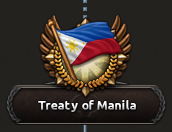 While economic recovery and eventually boom is the primary objective of this branch, the overarching pull is the quest for independence - and that can be reached in this branch through the Treaty of Manila. The design objective here was to make the path offer many choices and decision points to the player, while providing a big gameplay difference for choosing to side with the USA or with Japan.
While economic recovery and eventually boom is the primary objective of this branch, the overarching pull is the quest for independence - and that can be reached in this branch through the Treaty of Manila. The design objective here was to make the path offer many choices and decision points to the player, while providing a big gameplay difference for choosing to side with the USA or with Japan. 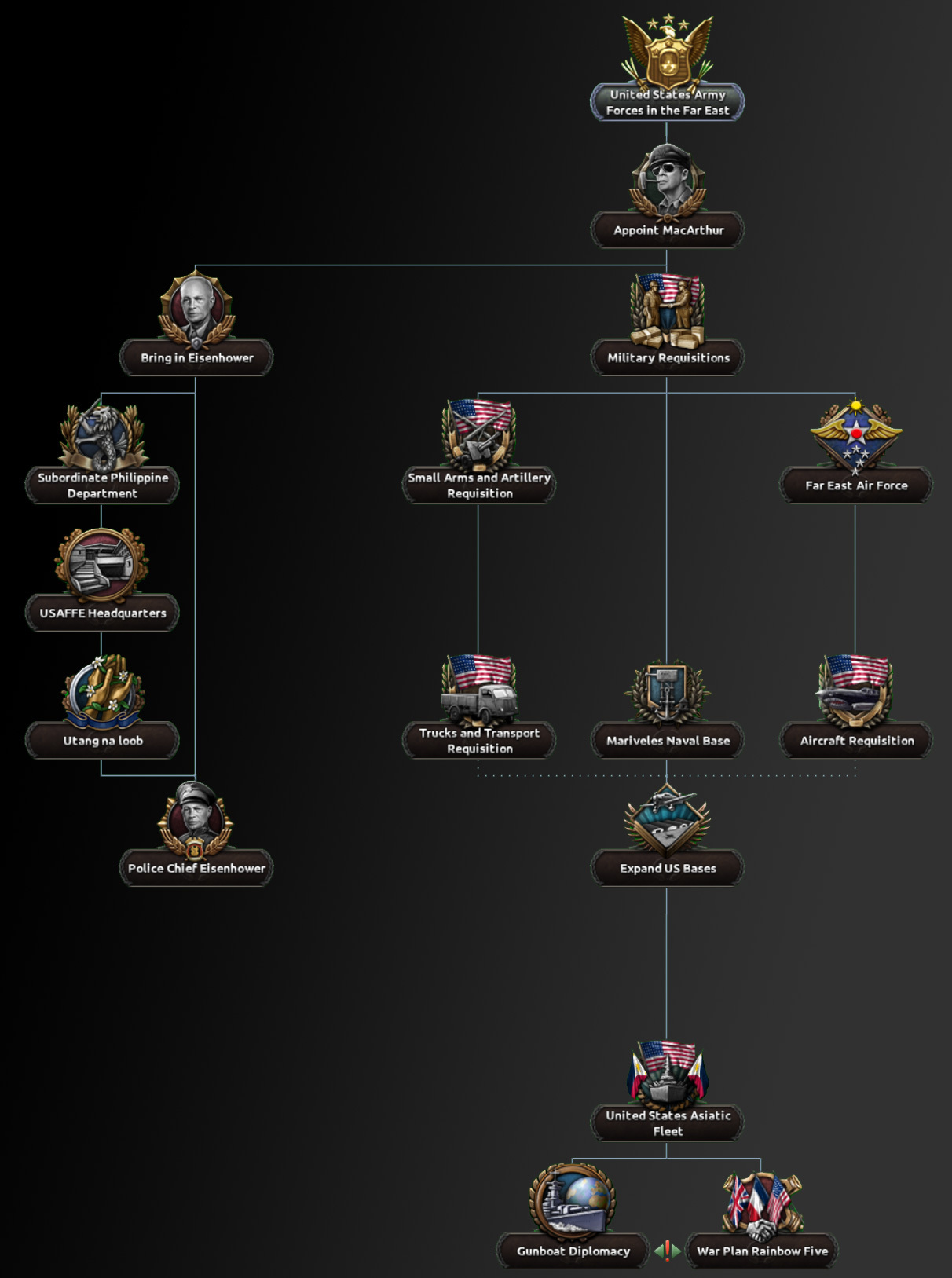 This kicked off a massive rearmament program with literally millions of rifles, artillery, aircraft, trucks and more being requisitioned (and approved) for use in the Philippines. In fact, a huge portion of these goods were actually en-route when Pearl Harbour happened, and the transport ships turned around. MacArthur had guessed that a potential Japanese invasion was still a few months away - but what if the rearmament process had started earlier? That’s the kind of question we love to ask when making these trees!
This kicked off a massive rearmament program with literally millions of rifles, artillery, aircraft, trucks and more being requisitioned (and approved) for use in the Philippines. In fact, a huge portion of these goods were actually en-route when Pearl Harbour happened, and the transport ships turned around. MacArthur had guessed that a potential Japanese invasion was still a few months away - but what if the rearmament process had started earlier? That’s the kind of question we love to ask when making these trees!  In 1935, the Sakdalista movement rose up en-mass with demands of independence, but were quickly suppressed by the American military. If the Philippines choose Leverage the Peso as their first economic milestone choice, they can Rebuild the Saksalistas. From there, there is a choice, the Slippery Slope of Fascism, or turning to old frenemies for help, starting with an Election Overturned.
In 1935, the Sakdalista movement rose up en-mass with demands of independence, but were quickly suppressed by the American military. If the Philippines choose Leverage the Peso as their first economic milestone choice, they can Rebuild the Saksalistas. From there, there is a choice, the Slippery Slope of Fascism, or turning to old frenemies for help, starting with an Election Overturned. 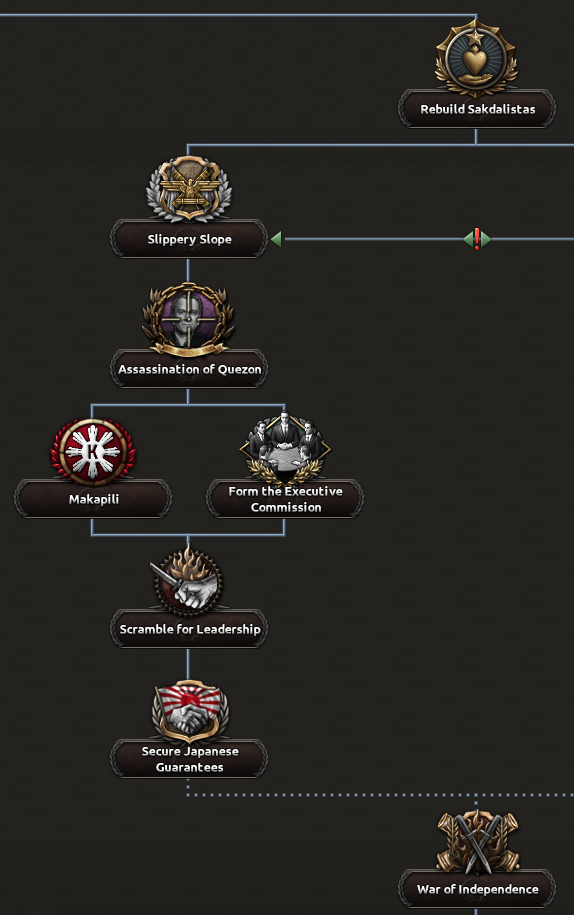 Sliding down the slippery slope will draw the nation closer to Japanese fascists, and seek their future support. The first step of the process is to remove the legitimate democratic leader Manuel Quezon, and use his death to spark a national crisis, from which the militant fascist faction can rise.
Sliding down the slippery slope will draw the nation closer to Japanese fascists, and seek their future support. The first step of the process is to remove the legitimate democratic leader Manuel Quezon, and use his death to spark a national crisis, from which the militant fascist faction can rise.  The Spanish Reconciliation branch starts out also with Rebuilding Sakdalistas, which gives Emilio Aguinaldo the popular support he needs to call in to question the results of the 1935 election between him and Manuel Quezon. At the time Aguinaldo claimed that there were electoral manipulations, and raised the issue up with the United States. Nothing came of it historically… but what if it did?
The Spanish Reconciliation branch starts out also with Rebuilding Sakdalistas, which gives Emilio Aguinaldo the popular support he needs to call in to question the results of the 1935 election between him and Manuel Quezon. At the time Aguinaldo claimed that there were electoral manipulations, and raised the issue up with the United States. Nothing came of it historically… but what if it did?  If the Fascists or Aguinaldo wins, then the Philippines can go on to form the Second Philippine Republic. Alternatively, under the Spanish Reconciliation branch, the Philippines can choose to crown Juan III as King, and create the Reino de Filipinas (Kingdom of the Philippines), and start to restore Spanish control to the former territories of the Spanish Empire.
If the Fascists or Aguinaldo wins, then the Philippines can go on to form the Second Philippine Republic. Alternatively, under the Spanish Reconciliation branch, the Philippines can choose to crown Juan III as King, and create the Reino de Filipinas (Kingdom of the Philippines), and start to restore Spanish control to the former territories of the Spanish Empire. 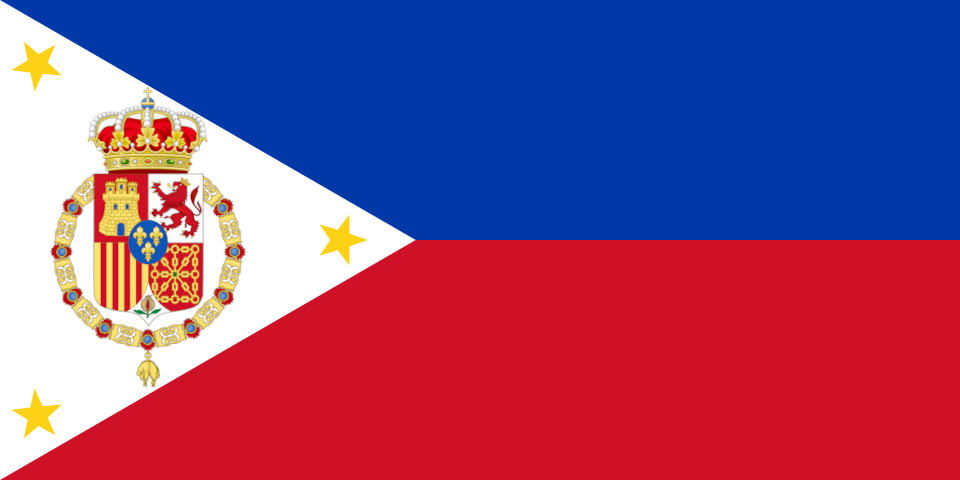 A quick note on the Reino de Filipinas flag: We do actually put a great deal of thought and effort into the flags of our nations, particularly for the alt-history ones, and I think that this is a great example. This flag is very similar to the flag of the Philippines today, however the 4th, largest sun in the center has been replaced with the crest of Infante Juan when he was pretender to the Spanish Throne. This is particularly pertinent, because that 4th sun was a symbol of the revolution against Spain so it would make sense that the new regime would want to replace that part.
A quick note on the Reino de Filipinas flag: We do actually put a great deal of thought and effort into the flags of our nations, particularly for the alt-history ones, and I think that this is a great example. This flag is very similar to the flag of the Philippines today, however the 4th, largest sun in the center has been replaced with the crest of Infante Juan when he was pretender to the Spanish Throne. This is particularly pertinent, because that 4th sun was a symbol of the revolution against Spain so it would make sense that the new regime would want to replace that part. In 1932, the Philippine Supreme Court banned communism, or more particularly the Partido Komunista ng Pilipinas (PKP). In 1938, the government under Quezon lifted this ban, recognising it as a legal political organization once again. It is through this chain of events that Communism can be revived in the Philippines.
In 1932, the Philippine Supreme Court banned communism, or more particularly the Partido Komunista ng Pilipinas (PKP). In 1938, the government under Quezon lifted this ban, recognising it as a legal political organization once again. It is through this chain of events that Communism can be revived in the Philippines. 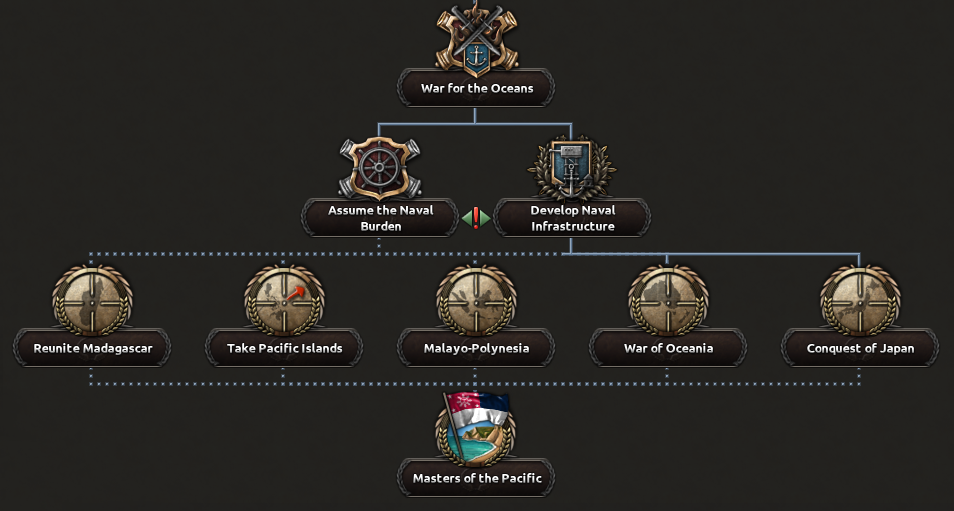 Well, this is a war game. So… war! War for the Oceans starts out by giving some more much needed naval production capabilities, which is expanded even further with Develop Naval Infrastructure. If this independent Philippines has managed to join the Japanese faction, then they can do Assume the Naval Burden instead which grants a portion of the Japanese fleet to the Philippines, under the understanding that the Philippines deals with the naval threats, allowing Japan to focus on their land-conquests.
Well, this is a war game. So… war! War for the Oceans starts out by giving some more much needed naval production capabilities, which is expanded even further with Develop Naval Infrastructure. If this independent Philippines has managed to join the Japanese faction, then they can do Assume the Naval Burden instead which grants a portion of the Japanese fleet to the Philippines, under the understanding that the Philippines deals with the naval threats, allowing Japan to focus on their land-conquests. 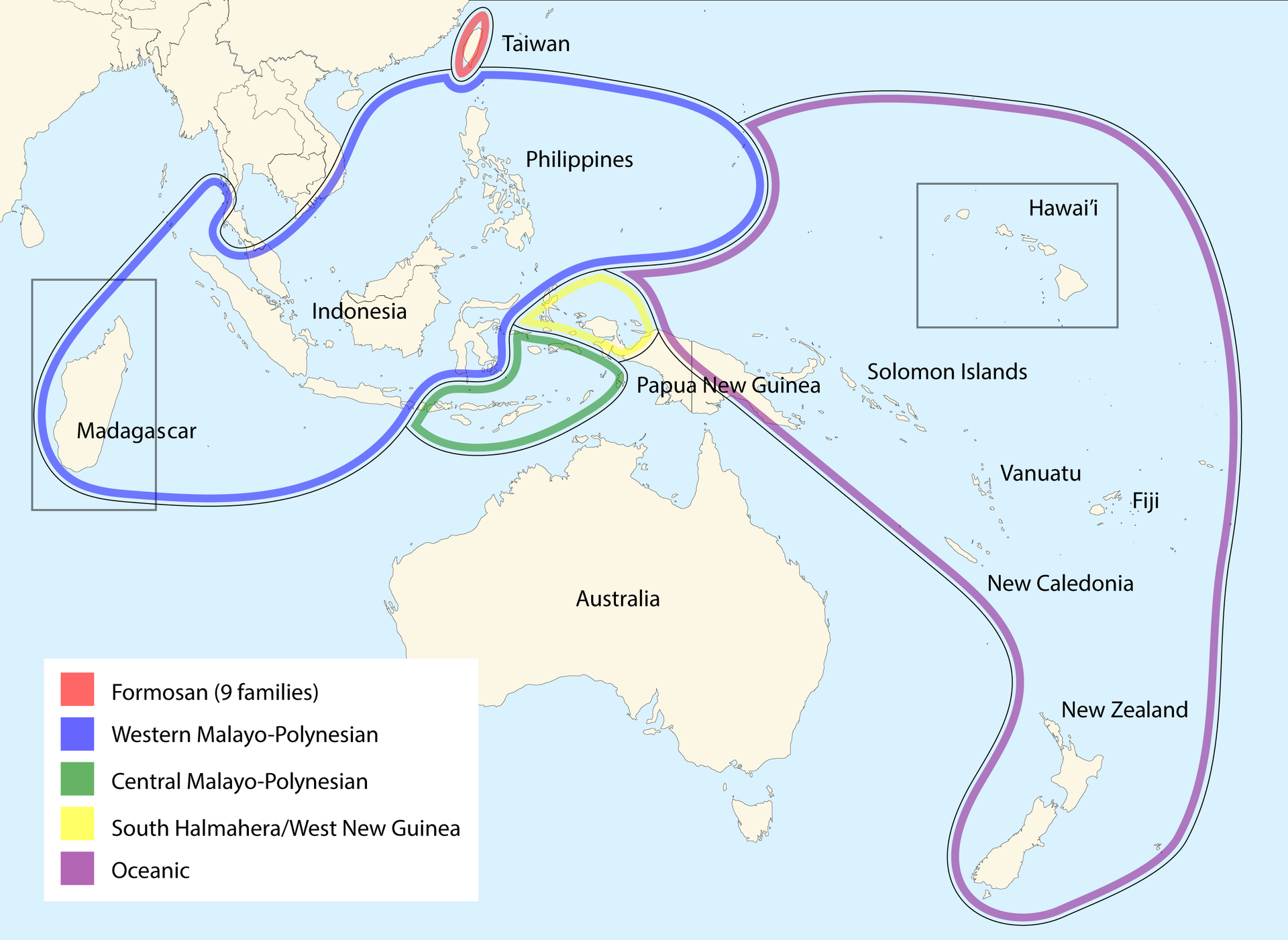 For the Philippines we looked to their Austronesian connections and used those. Geographical areas with significant Austronesian populations were considered for claims and cores- this is how Madagascar made the list! Oceania and Japan grant claims but not cores. They are strategically valuable to an expanded Philippines, but they do not share those cultural and ethnic connections.
For the Philippines we looked to their Austronesian connections and used those. Geographical areas with significant Austronesian populations were considered for claims and cores- this is how Madagascar made the list! Oceania and Japan grant claims but not cores. They are strategically valuable to an expanded Philippines, but they do not share those cultural and ethnic connections.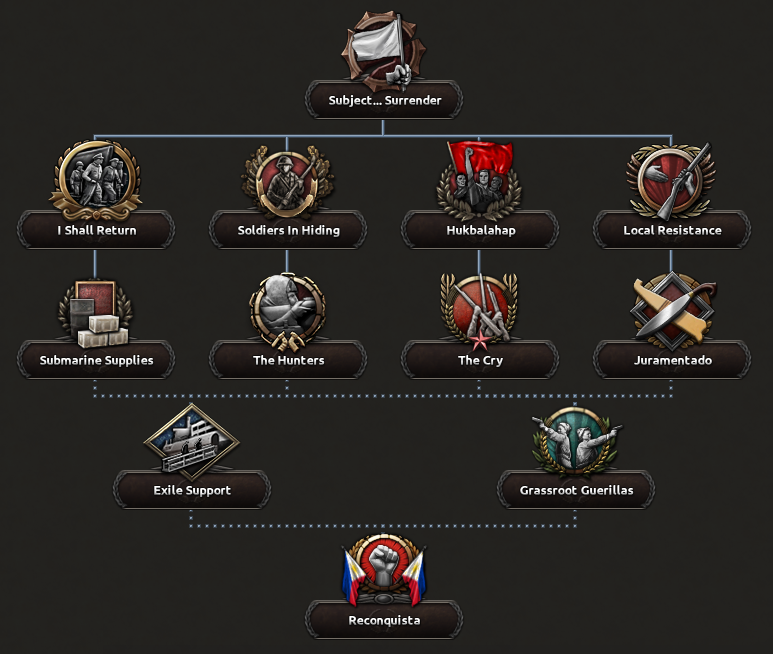 This is especially true for AI Philippines on Historical, because we do try to design content, particularly with minor nations, with AI use in mind. We think it’s valuable for AI nations to behave in a believable manner, using tactics and advantages they historically did.
This is especially true for AI Philippines on Historical, because we do try to design content, particularly with minor nations, with AI use in mind. We think it’s valuable for AI nations to behave in a believable manner, using tactics and advantages they historically did.  The National Defense act stands as the gateway to most (but not all) of the military branches. As we discussed in the Dev Corner, this stands as the longest focus to complete in the game, 245 days straight out of the box. You will notice the clock there however, which denotes this as one of the focuses to be sped up- this one by completing any of the Economic milestone focuses, left or right side all the way down to just 35 days. It is therefore up to the player to determine when it’s time to trigger the Defense Act, and thus begin rearming the nation in earnest.
The National Defense act stands as the gateway to most (but not all) of the military branches. As we discussed in the Dev Corner, this stands as the longest focus to complete in the game, 245 days straight out of the box. You will notice the clock there however, which denotes this as one of the focuses to be sped up- this one by completing any of the Economic milestone focuses, left or right side all the way down to just 35 days. It is therefore up to the player to determine when it’s time to trigger the Defense Act, and thus begin rearming the nation in earnest. 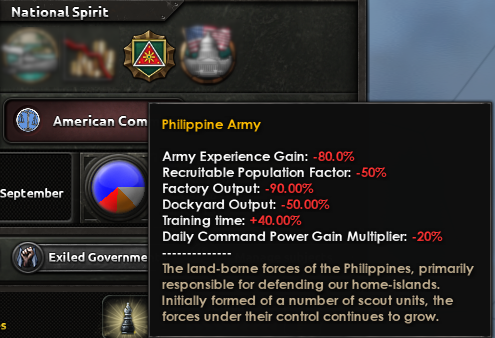 The National Defense Act focus alone increases factory output by 75%, and dockyard output by 50%, leaving just -15% factory output, and entirely removing the negative dockyard modifier. Quite a big difference! Once that hurdle is overcome, access is gained to the Defensive, Army and Air Force branches… with an obvious branch missing from that collection. More about them later!
The National Defense Act focus alone increases factory output by 75%, and dockyard output by 50%, leaving just -15% factory output, and entirely removing the negative dockyard modifier. Quite a big difference! Once that hurdle is overcome, access is gained to the Defensive, Army and Air Force branches… with an obvious branch missing from that collection. More about them later!  The early part of the branch gives access to much needed dockyards and dockyard output so that you can put some ships out to sea before any conflicts begin in earnest. To progress further though, from the PT Boat Development focus onwards, you will still need to complete the National Defense Act.
The early part of the branch gives access to much needed dockyards and dockyard output so that you can put some ships out to sea before any conflicts begin in earnest. To progress further though, from the PT Boat Development focus onwards, you will still need to complete the National Defense Act. We have toyed with a lot of different ways to represent Patrol Boats (PT Boats) in the game, from entirely new ship hulls, to an in-shore minlaying analogue, but ultimately decided to use the new Doctrine system - adding the Patrol Boat doctrine. The Philippines can really specialise in this, gaining a bonus to Patrol Boat doctrine mastery gain as well as adjusting how their destroyer hulls function.
We have toyed with a lot of different ways to represent Patrol Boats (PT Boats) in the game, from entirely new ship hulls, to an in-shore minlaying analogue, but ultimately decided to use the new Doctrine system - adding the Patrol Boat doctrine. The Philippines can really specialise in this, gaining a bonus to Patrol Boat doctrine mastery gain as well as adjusting how their destroyer hulls function.  All is not bad on the national spirit side either, whereas the other spirits tended to be quite (ok, very) negative. The Philippines also begin with the Island Nation spirit, giving a bonus to convoy production, convoy retreat speed, and a visibility reduction to enable more hit and run engagements. Speaking of convoys, the Philippines can trade in some of their maritime trade capability in exchange for infrastructure and weapons, if they complete the right economic focuses.
All is not bad on the national spirit side either, whereas the other spirits tended to be quite (ok, very) negative. The Philippines also begin with the Island Nation spirit, giving a bonus to convoy production, convoy retreat speed, and a visibility reduction to enable more hit and run engagements. Speaking of convoys, the Philippines can trade in some of their maritime trade capability in exchange for infrastructure and weapons, if they complete the right economic focuses.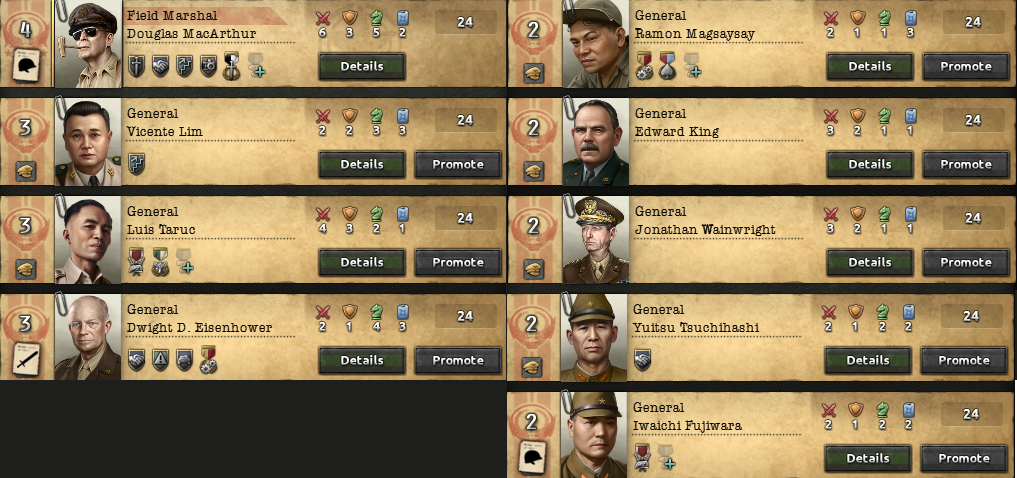 We’re looking into giving Jonathan Wainwright a new portrait, as his current one is from after his incarceration. Likewise for Arthur Percival (for the British).
We’re looking into giving Jonathan Wainwright a new portrait, as his current one is from after his incarceration. Likewise for Arthur Percival (for the British). 

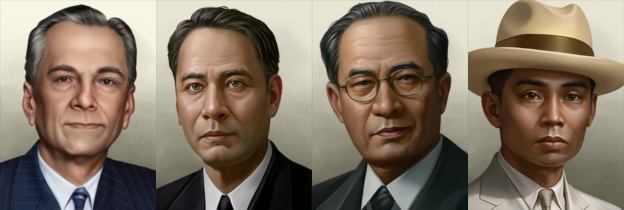 Manuel Quezon, Manuel Roxas, Jose Laurel, Crisanto Evangelista
Manuel Quezon, Manuel Roxas, Jose Laurel, Crisanto Evangelista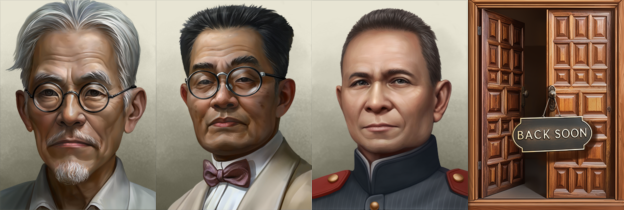 Pedro Abad Santos, Emilio Aguinaldo, Artemio Ricarte, Interregnum
Pedro Abad Santos, Emilio Aguinaldo, Artemio Ricarte, Interregnum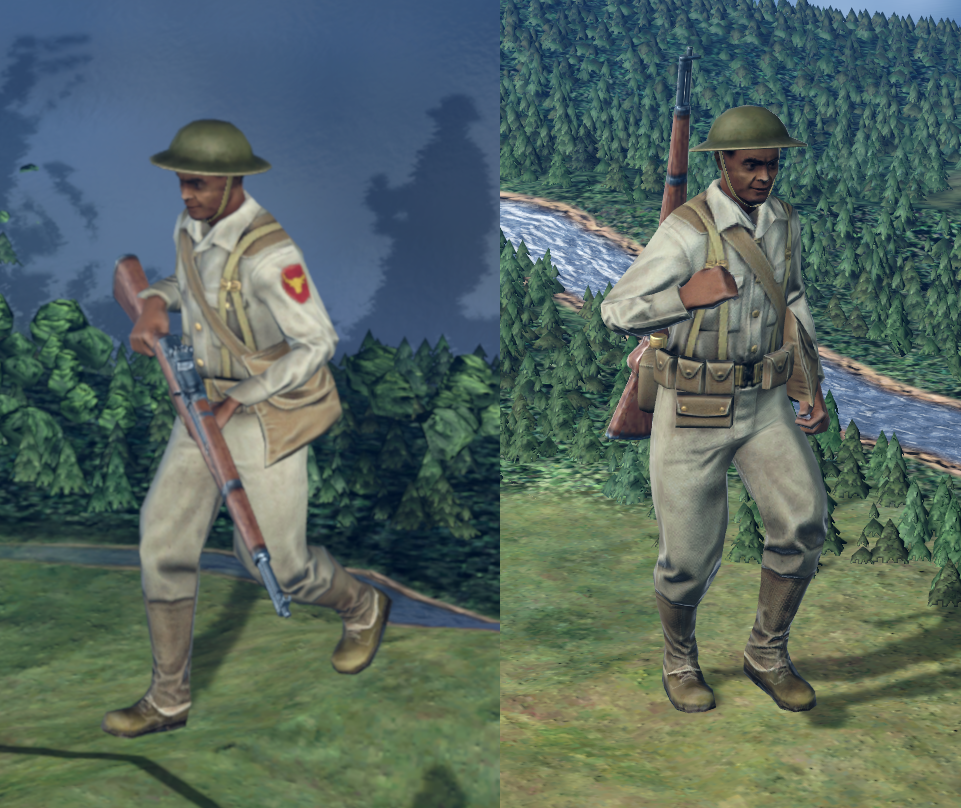 Philippine Infantry
Philippine Infantry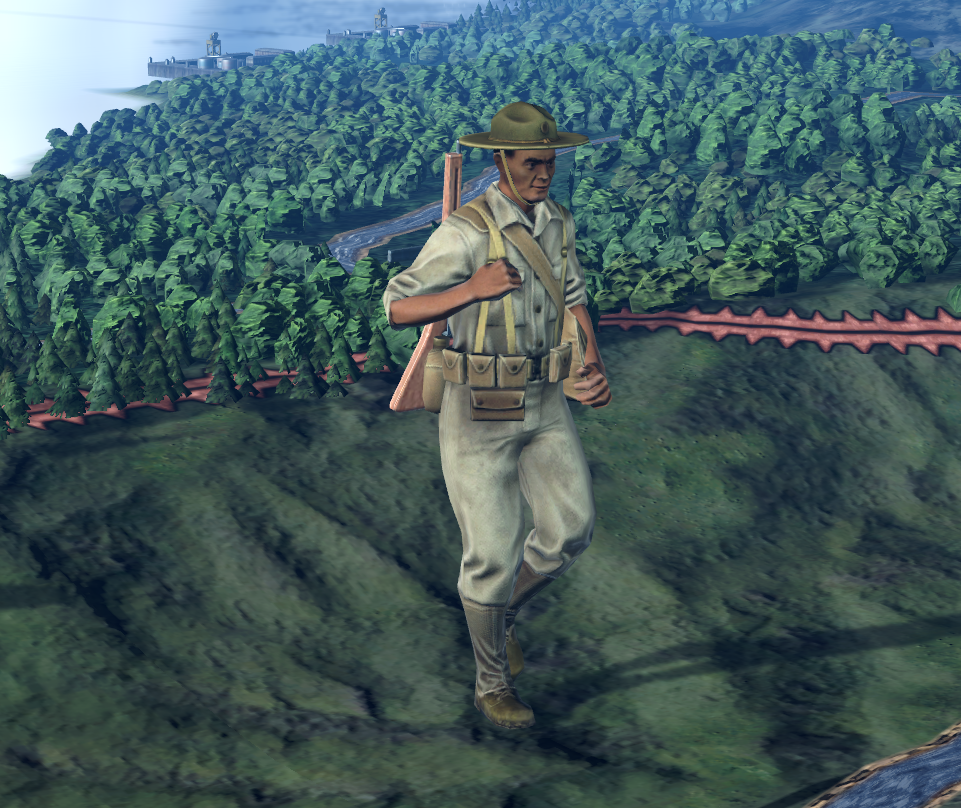 Philippine Scout (Ranger)
Philippine Scout (Ranger)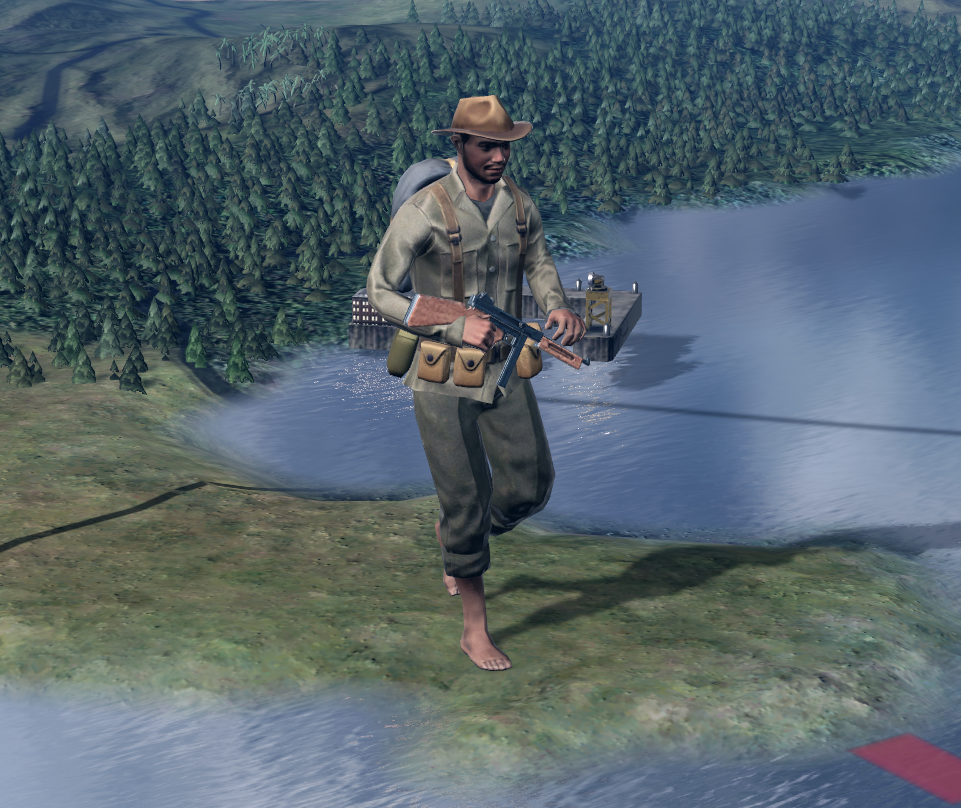 Philippine Marine
Philippine Marine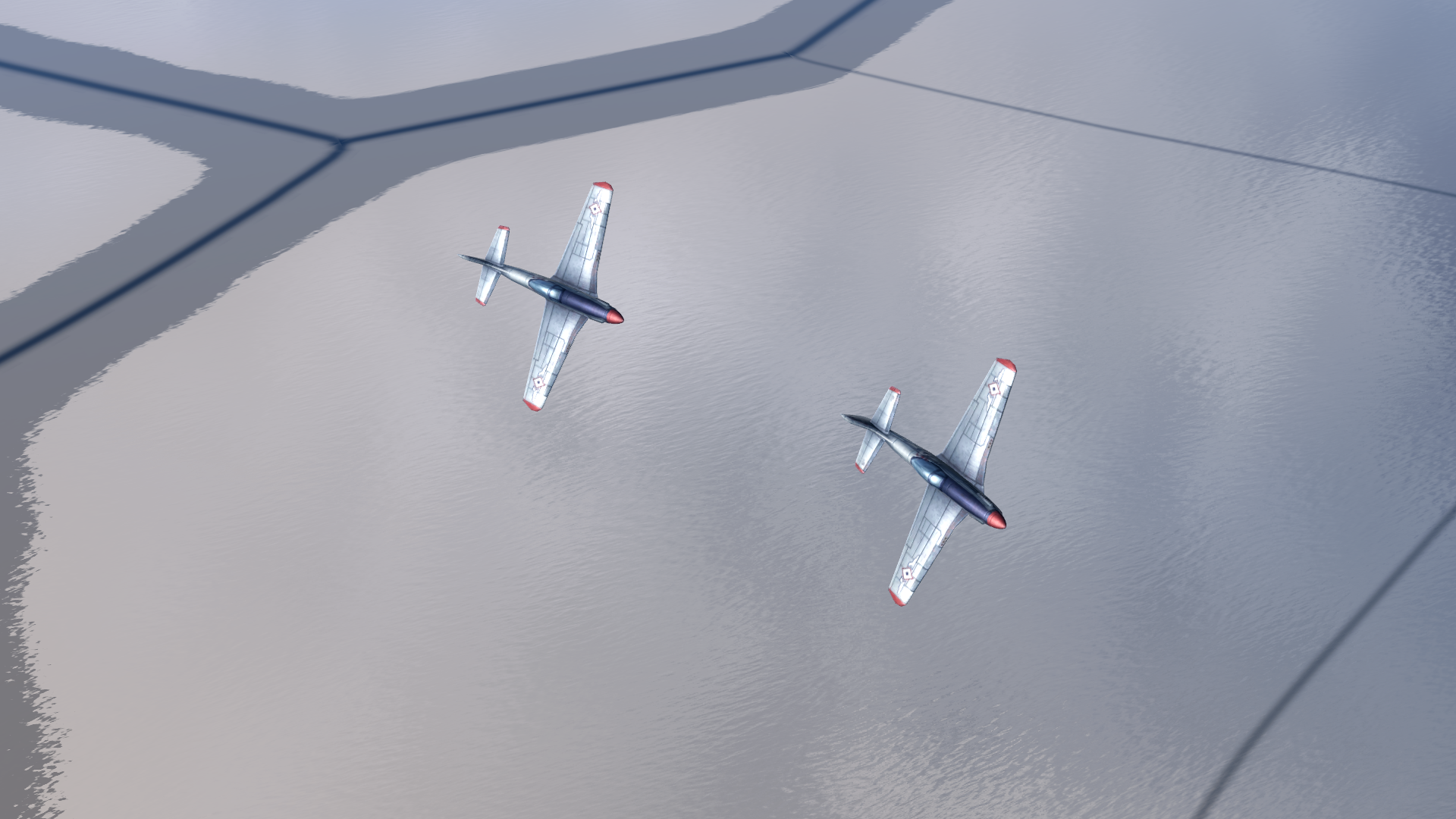 And finally, some Philippine zoom zooms!
And finally, some Philippine zoom zooms!  We actually had a little difficulty differentiating Philippine tanks and planes from American ones, because during this period they tended to use the exact same equipment, but we’ve reskinned a bunch of US models and added the Philippine roundel (without wings for the land units), and changed up some of the colours. We also took this opportunity to improve the texture quality of those Philippine units.
We actually had a little difficulty differentiating Philippine tanks and planes from American ones, because during this period they tended to use the exact same equipment, but we’ve reskinned a bunch of US models and added the Philippine roundel (without wings for the land units), and changed up some of the colours. We also took this opportunity to improve the texture quality of those Philippine units. 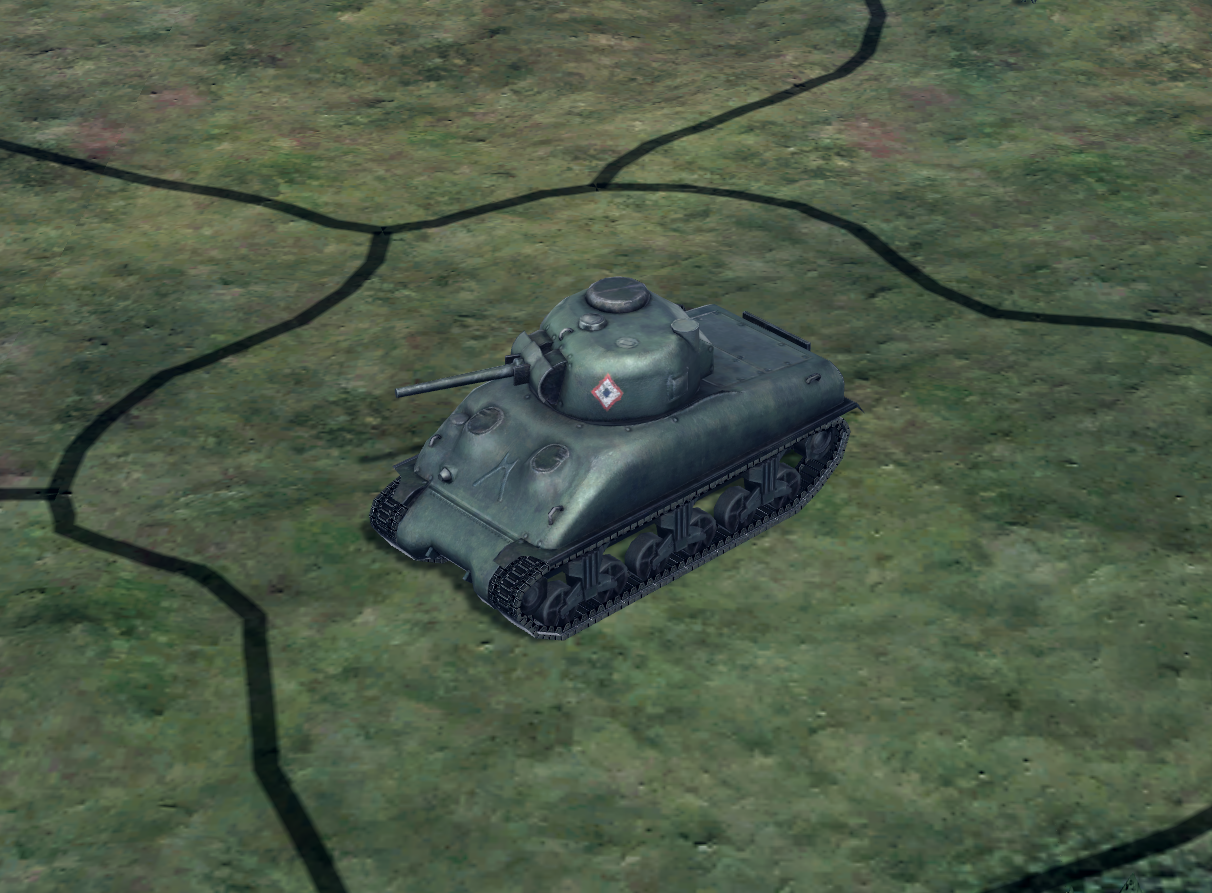 I think that’s your lot for today, please do leave feedback below - I always really appreciate the insight you all provide. While making big sweeping changes at this point is unlikely, we can always tweak this and that. Similarly if you have any questions about what has been revealed (and what hasn’t) then please do let us know!
I think that’s your lot for today, please do leave feedback below - I always really appreciate the insight you all provide. While making big sweeping changes at this point is unlikely, we can always tweak this and that. Similarly if you have any questions about what has been revealed (and what hasn’t) then please do let us know!




 Hey folks, ImaginedPanda here! I’m one of the designers working on Nationalist China and will be taking you through a quick tour of the new content coming in No Compromise, No Surrender. If you don’t recognize the name it is because this is my first time writing a Dev Diary and if you do recognize the name it’s because I’ve been answering when you’ve reported bugs on the forums. Keep doing that, you guys are awesome! Enough of that though onto Nationalist China!
Hey folks, ImaginedPanda here! I’m one of the designers working on Nationalist China and will be taking you through a quick tour of the new content coming in No Compromise, No Surrender. If you don’t recognize the name it is because this is my first time writing a Dev Diary and if you do recognize the name it’s because I’ve been answering when you’ve reported bugs on the forums. Keep doing that, you guys are awesome! Enough of that though onto Nationalist China!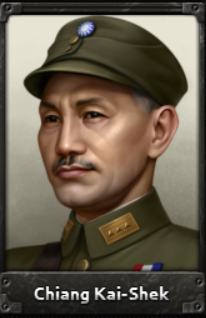
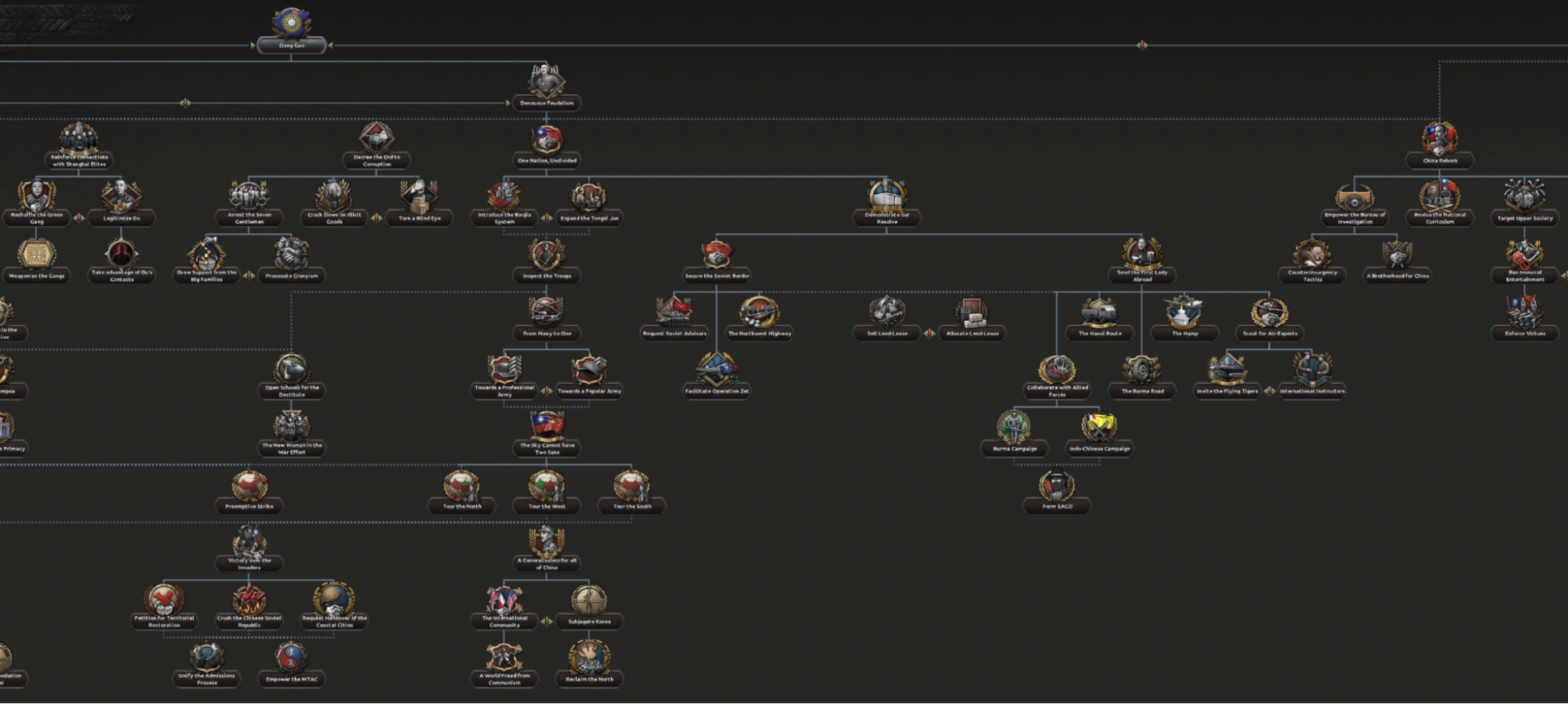 We’ll start off talking about Chiang Kai-shek: a military leader through and through, Chiang asserted his power and assured loyalty through the army and the Whampoa Military Academy. What this means is that playing as Chiang Kai-shek you will focus heavily on using the new faction system where you will use your influence to force the different warlords into becoming your subjects.
We’ll start off talking about Chiang Kai-shek: a military leader through and through, Chiang asserted his power and assured loyalty through the army and the Whampoa Military Academy. What this means is that playing as Chiang Kai-shek you will focus heavily on using the new faction system where you will use your influence to force the different warlords into becoming your subjects.
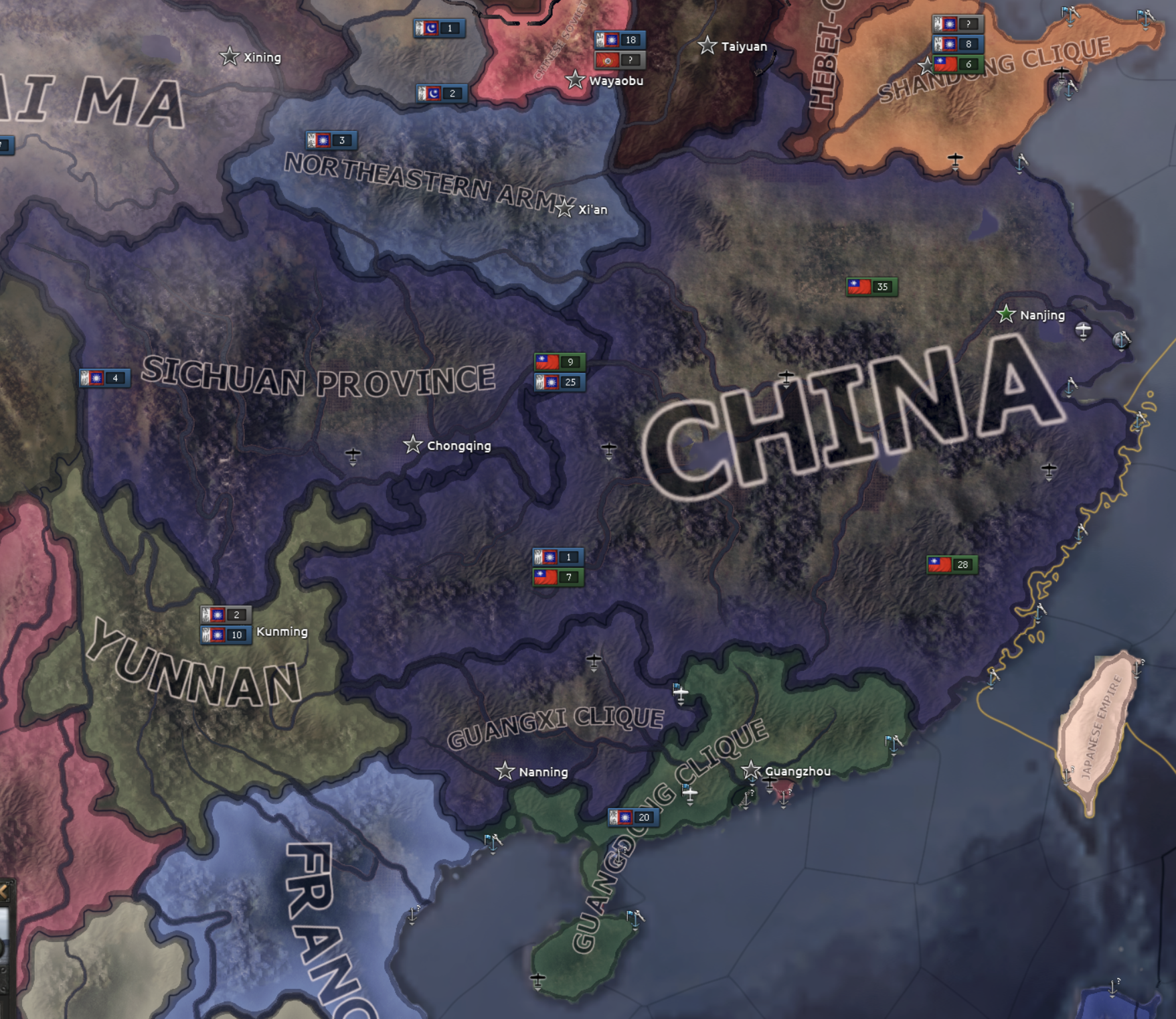 The stronger a military leader you are the more you will be able to integrate.
The stronger a military leader you are the more you will be able to integrate.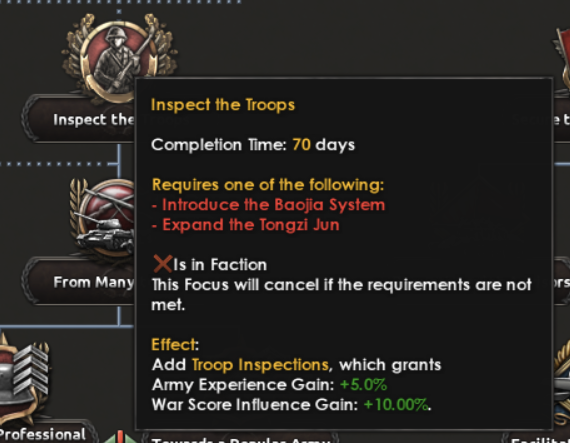 As China was a big recipient of lend-lease so we also wanted to give you gameplay around this and have added a mini-branch for this where you will be able to build up both your economy and arsenal.
As China was a big recipient of lend-lease so we also wanted to give you gameplay around this and have added a mini-branch for this where you will be able to build up both your economy and arsenal.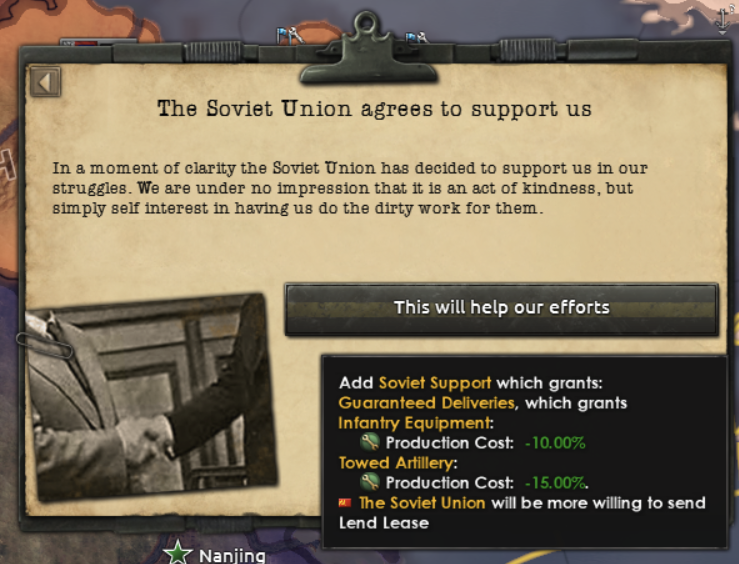
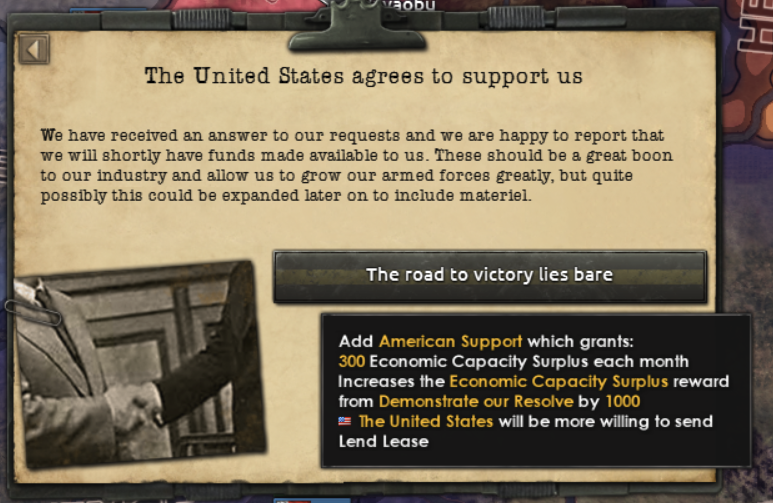
 Wang Jingwei can be described as Chiang Kai Shek's greatest adversary within the KMT of the period.
Wang Jingwei can be described as Chiang Kai Shek's greatest adversary within the KMT of the period. 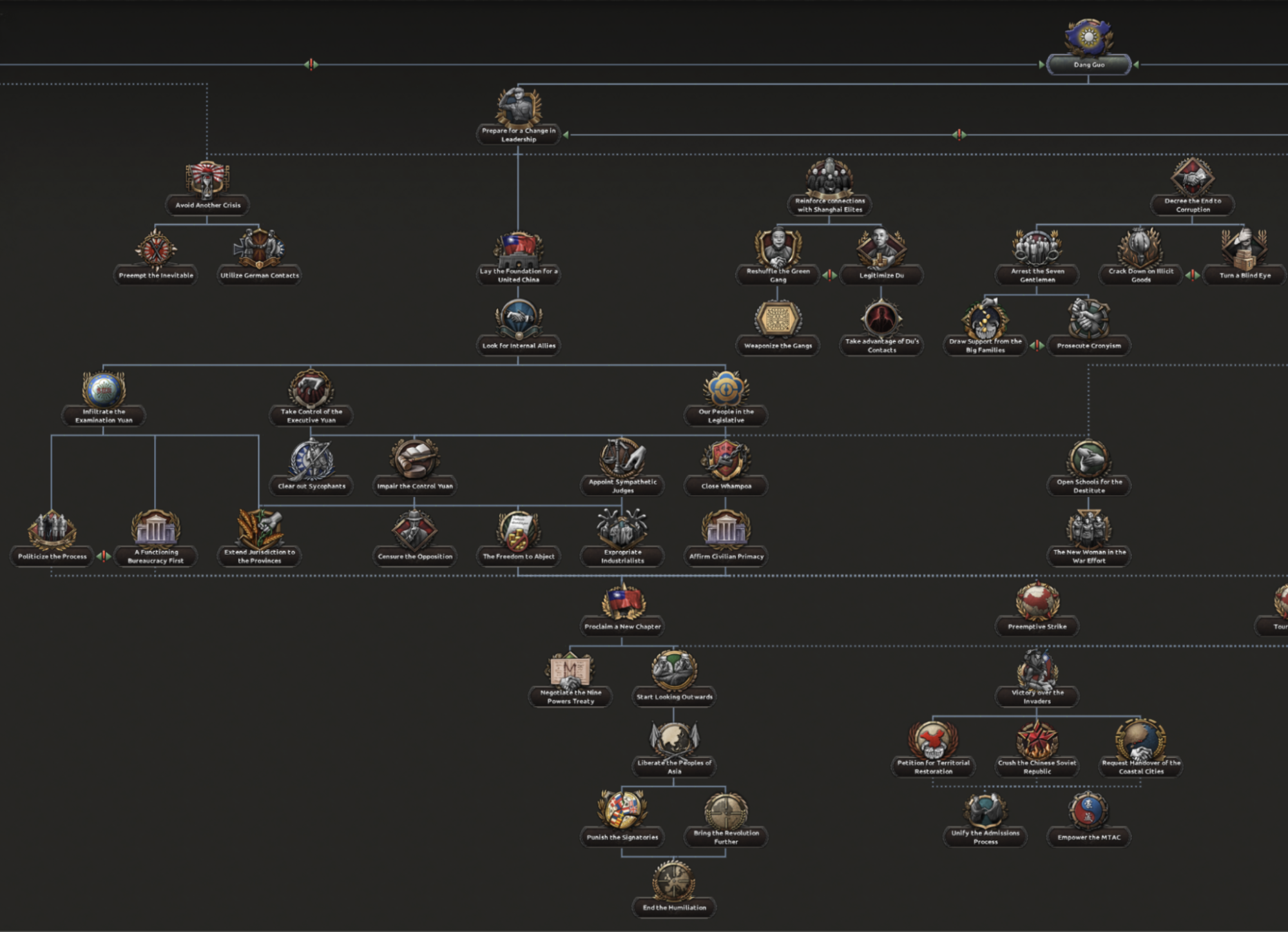 Unlike Chiang, Wang wasn’t militarily trained and more of a politician so we’ve taken to this difference to make this path feel different. In this path you will get rid of Chiang and start solidifying your power through taking over the central government institutions, known as the Yuans.
Unlike Chiang, Wang wasn’t militarily trained and more of a politician so we’ve taken to this difference to make this path feel different. In this path you will get rid of Chiang and start solidifying your power through taking over the central government institutions, known as the Yuans. 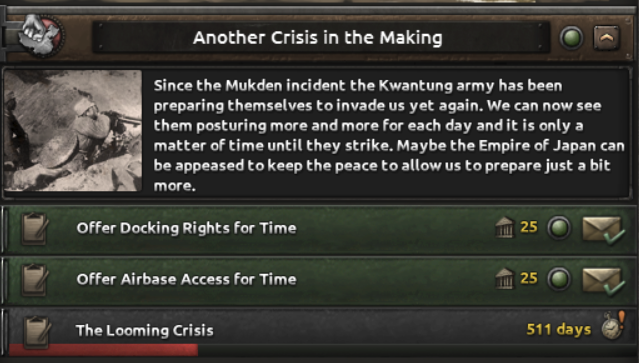
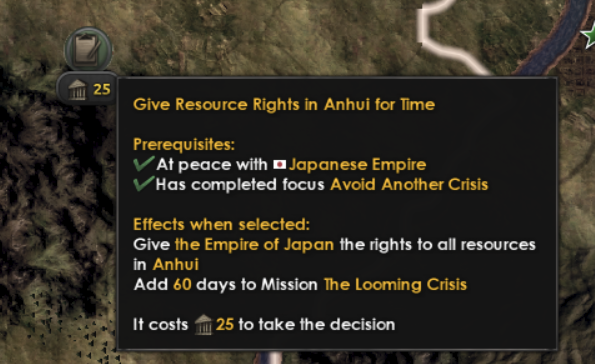 When having thrown out the invaders and unified your country you get to help others to do the same, as well as punish the damn imperialists. Don’t worry though, you will be appropriately rewarded for helping your fellow asians throw off the yoke of colonialism.
When having thrown out the invaders and unified your country you get to help others to do the same, as well as punish the damn imperialists. Don’t worry though, you will be appropriately rewarded for helping your fellow asians throw off the yoke of colonialism.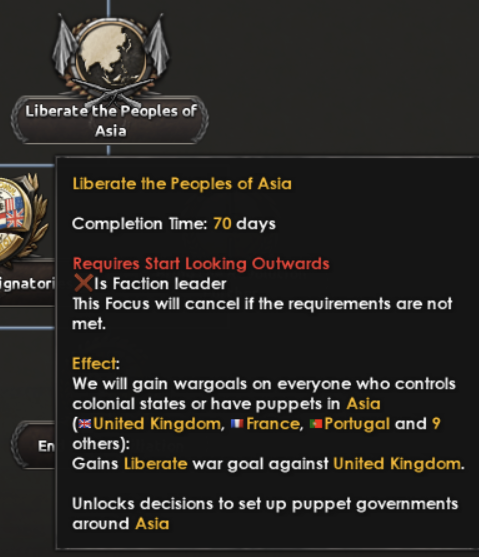
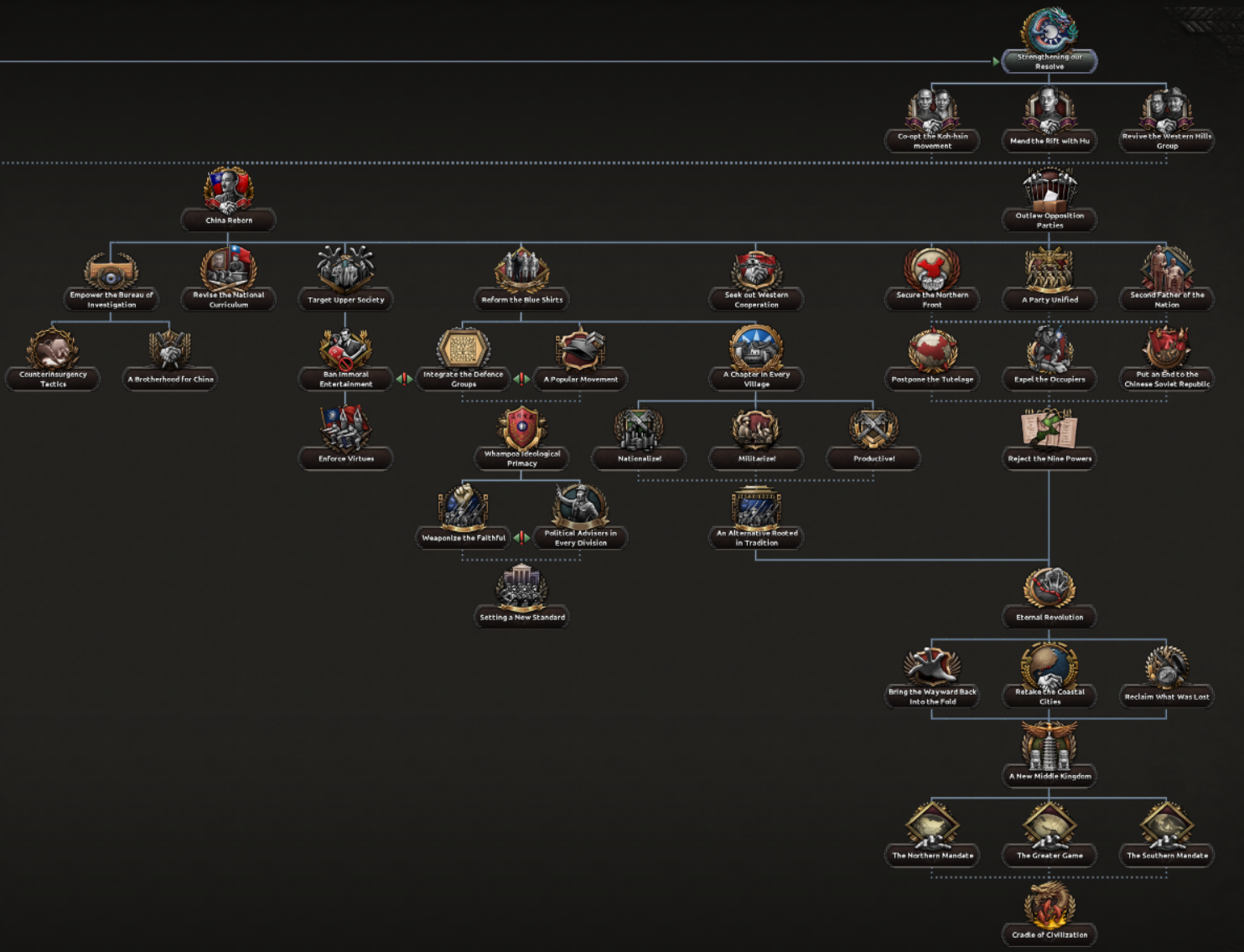 Something that should have become clear at this point is that armed conflict will come to you earlier than you might have preferred. This might feel somewhat overwhelming for some players, but then you have the kind of player that prefers when every border is a frontline. At least you know what kind of relation you have with them then.
Something that should have become clear at this point is that armed conflict will come to you earlier than you might have preferred. This might feel somewhat overwhelming for some players, but then you have the kind of player that prefers when every border is a frontline. At least you know what kind of relation you have with them then. 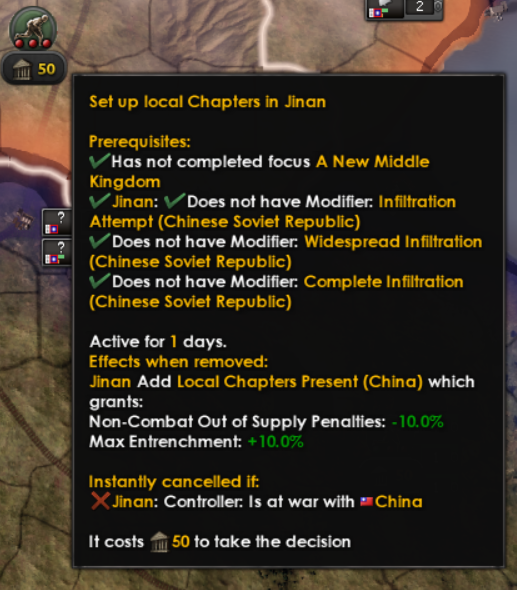 When you’ve brought the revolution of Dr Sun Yat-sen to all of China you will strike outwards, taking control over areas in your vicinity and building a continental empire. By successfully conquering claimed areas you will be rewarded with more efficient resource extraction and, more importantly, the ability to integrate the states into your glorious empire. Proving yet again that the world revolves around you.
When you’ve brought the revolution of Dr Sun Yat-sen to all of China you will strike outwards, taking control over areas in your vicinity and building a continental empire. By successfully conquering claimed areas you will be rewarded with more efficient resource extraction and, more importantly, the ability to integrate the states into your glorious empire. Proving yet again that the world revolves around you. During the time period there were several smaller groups during the time that challenged the KMT, and some of them unified into what came to be known as the China Democratic League, which became the largest opposition apart from the CCP.
During the time period there were several smaller groups during the time that challenged the KMT, and some of them unified into what came to be known as the China Democratic League, which became the largest opposition apart from the CCP.  But just uniting small ideological groups does not make a movement and you still need the backing of the populace. To get them on your side you will be applying the teaching of Dr Sun guiding them towards a better future.
But just uniting small ideological groups does not make a movement and you still need the backing of the populace. To get them on your side you will be applying the teaching of Dr Sun guiding them towards a better future.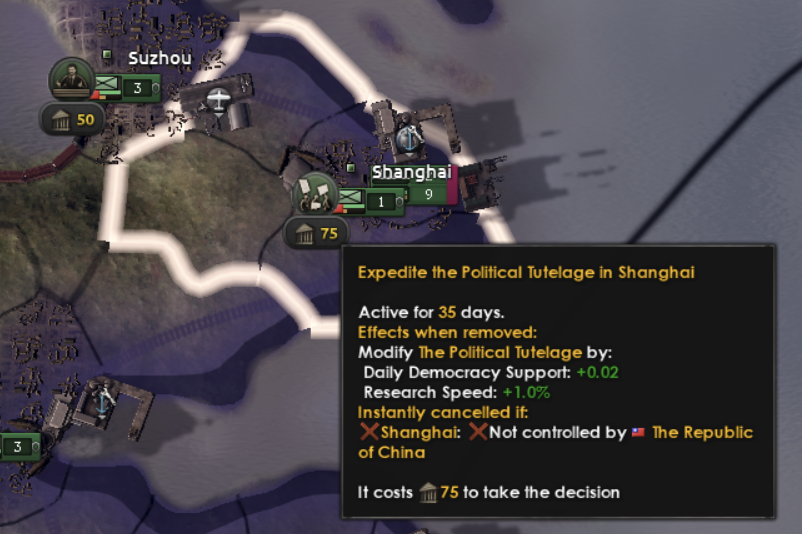 So that is how you make your country turn Democratic, but that wouldn’t be worth a lot if you can’t keep your sovereignty. As you might have guessed the Japanese invasion won’t be stopped simply because you have another party in power so you will have to deal with them.
So that is how you make your country turn Democratic, but that wouldn’t be worth a lot if you can’t keep your sovereignty. As you might have guessed the Japanese invasion won’t be stopped simply because you have another party in power so you will have to deal with them.
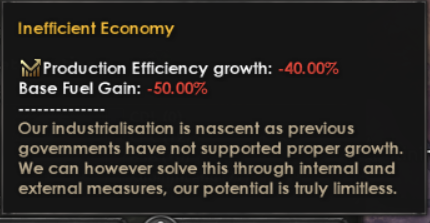
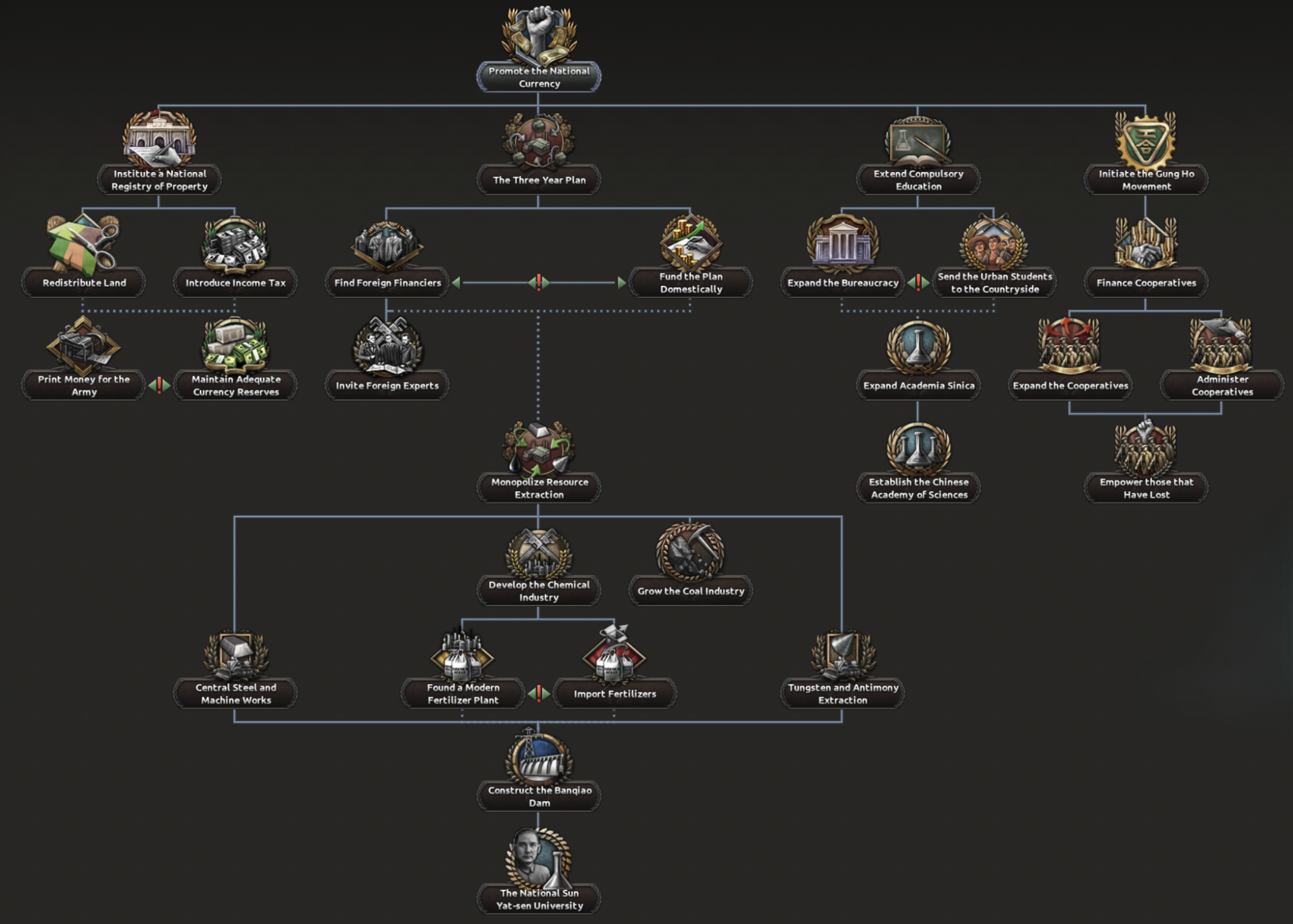 Chinese industry in the period had a large part that was foreign financed so we wanted to give you the option to do the same. If you have played your cards right you will be able to get large amounts of support from foreign sources.
Chinese industry in the period had a large part that was foreign financed so we wanted to give you the option to do the same. If you have played your cards right you will be able to get large amounts of support from foreign sources. 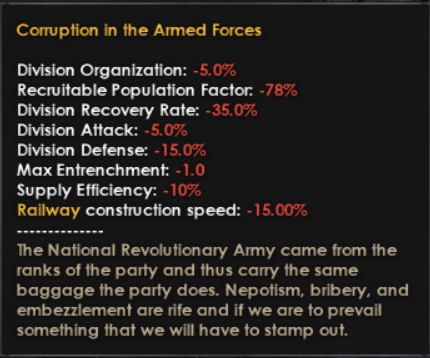 The National Revolutionary army of the 1930s was not the most well trained, nor equipped, but in the 20s it became self-evident to many in the military that a confrontation with the Japanese was inevitable. Two strategies to solve this inevitability emerged, Protracted Warfare and Decisive Battles.
The National Revolutionary army of the 1930s was not the most well trained, nor equipped, but in the 20s it became self-evident to many in the military that a confrontation with the Japanese was inevitable. Two strategies to solve this inevitability emerged, Protracted Warfare and Decisive Battles.  The former was based on the perception that the Japanese had no staying power and the longer the war took, the lower their chance of winning. This path gives you solid bonuses to your defence and the possibility to burn the enemy's supply lines from the rear. You will also be able to focus your defensive efforts in specific states to pin the enemy down where it is the most beneficial to you
The former was based on the perception that the Japanese had no staying power and the longer the war took, the lower their chance of winning. This path gives you solid bonuses to your defence and the possibility to burn the enemy's supply lines from the rear. You will also be able to focus your defensive efforts in specific states to pin the enemy down where it is the most beneficial to you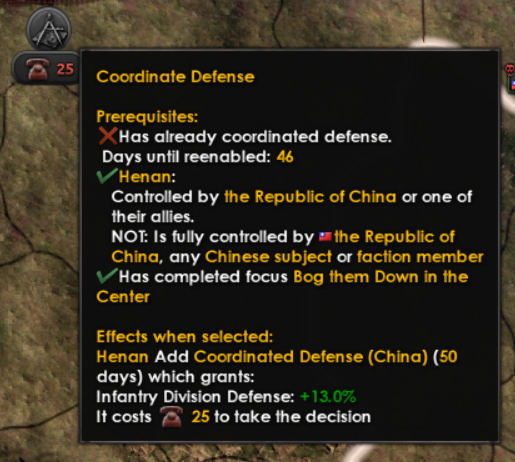 Ironically, the concept of Decisive Battles was influenced by the Japanese themselves in 1905 against the Russian empire. The idea was formed that if you win key engagements you break the will of the enemy so quick and fast strikes wins the war. Here your ability to strike back at the enemy and preempt their attacks takes centre state from the more careful approach. Similarly here you will be able to target specific states with your offensive capabilities proving once and for all that you only have to break them once if you do it well.
Ironically, the concept of Decisive Battles was influenced by the Japanese themselves in 1905 against the Russian empire. The idea was formed that if you win key engagements you break the will of the enemy so quick and fast strikes wins the war. Here your ability to strike back at the enemy and preempt their attacks takes centre state from the more careful approach. Similarly here you will be able to target specific states with your offensive capabilities proving once and for all that you only have to break them once if you do it well. As you can see we have chosen to represent these ideas in two different branches, but unlike how we’ve done in army branches in the past, going down one won’t lock you into that choice for the rest of your playthrough. When choosing one path you only lock yourself into that branch temporarily until you’ve taken the last focus in the branch. This means that if you are not ready for beating the invaders you can go down the more defensive branch slowing them down, and when you feel ready to strike back you start taking offensive focuses.
As you can see we have chosen to represent these ideas in two different branches, but unlike how we’ve done in army branches in the past, going down one won’t lock you into that choice for the rest of your playthrough. When choosing one path you only lock yourself into that branch temporarily until you’ve taken the last focus in the branch. This means that if you are not ready for beating the invaders you can go down the more defensive branch slowing them down, and when you feel ready to strike back you start taking offensive focuses.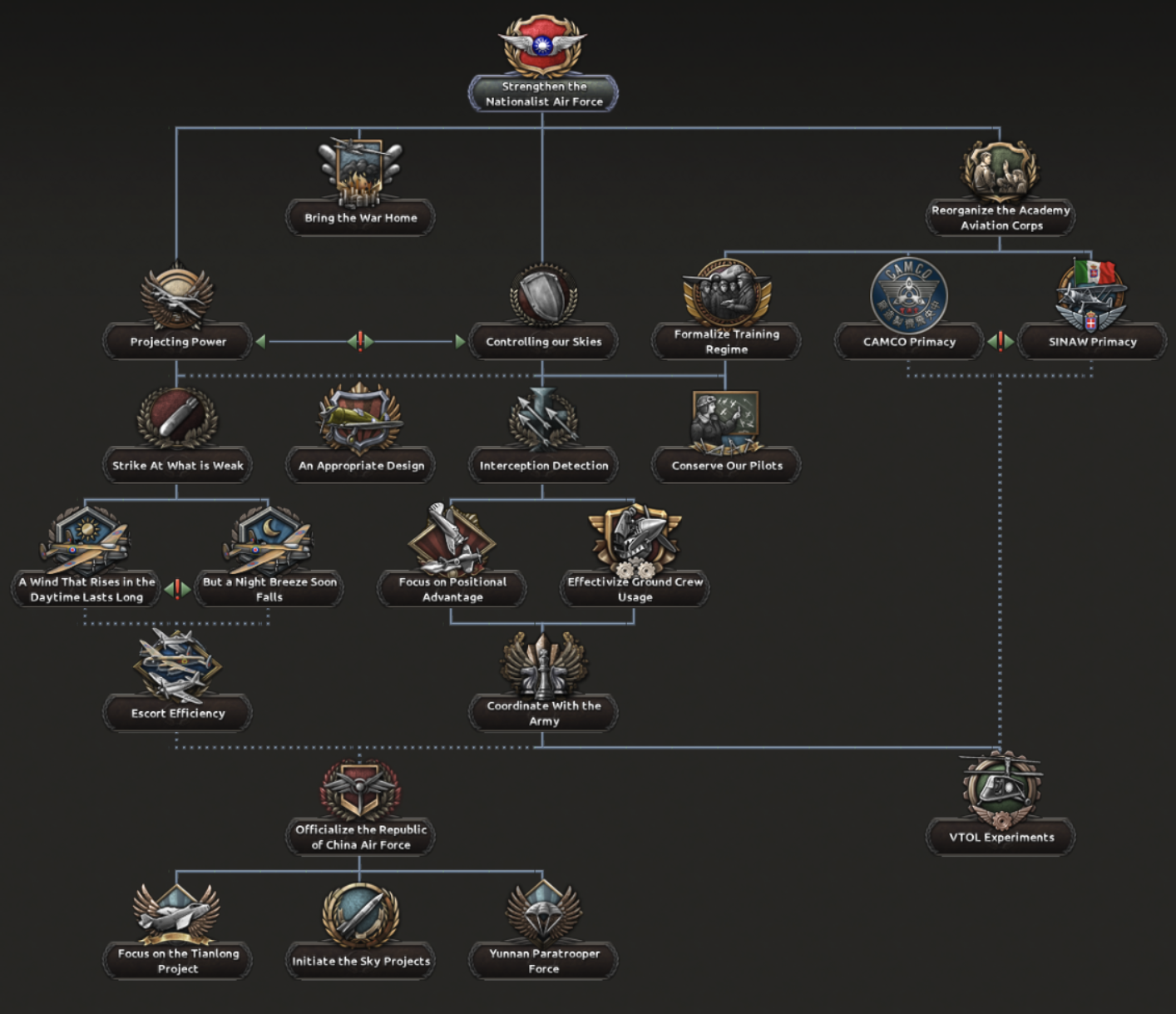 The main choice is if your airforce is going to be shaped into an offensive tool to project power and strike the enemy abroad, or if controlling your own backyard takes precedence. This ties into the changes we’ve done to doctrines of course.
The main choice is if your airforce is going to be shaped into an offensive tool to project power and strike the enemy abroad, or if controlling your own backyard takes precedence. This ties into the changes we’ve done to doctrines of course.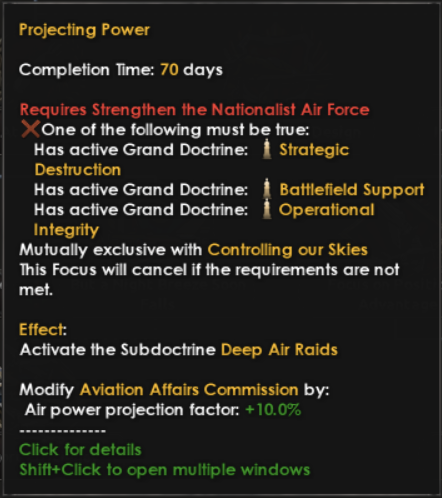
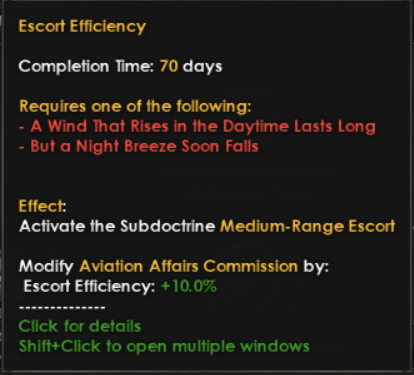 You will of course also have options of which organisation should manufacture your planes either going with the Central Aircraft Manufacturing Company, CAMCO, with their focus on high-powered interceptors, or the Sino-Italian National Aircraft Works, SINAW, specialising in medium sized bomber aircraft.
You will of course also have options of which organisation should manufacture your planes either going with the Central Aircraft Manufacturing Company, CAMCO, with their focus on high-powered interceptors, or the Sino-Italian National Aircraft Works, SINAW, specialising in medium sized bomber aircraft. 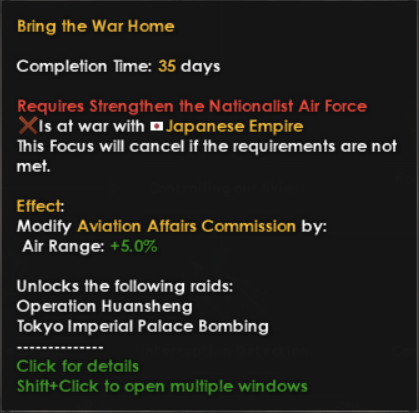
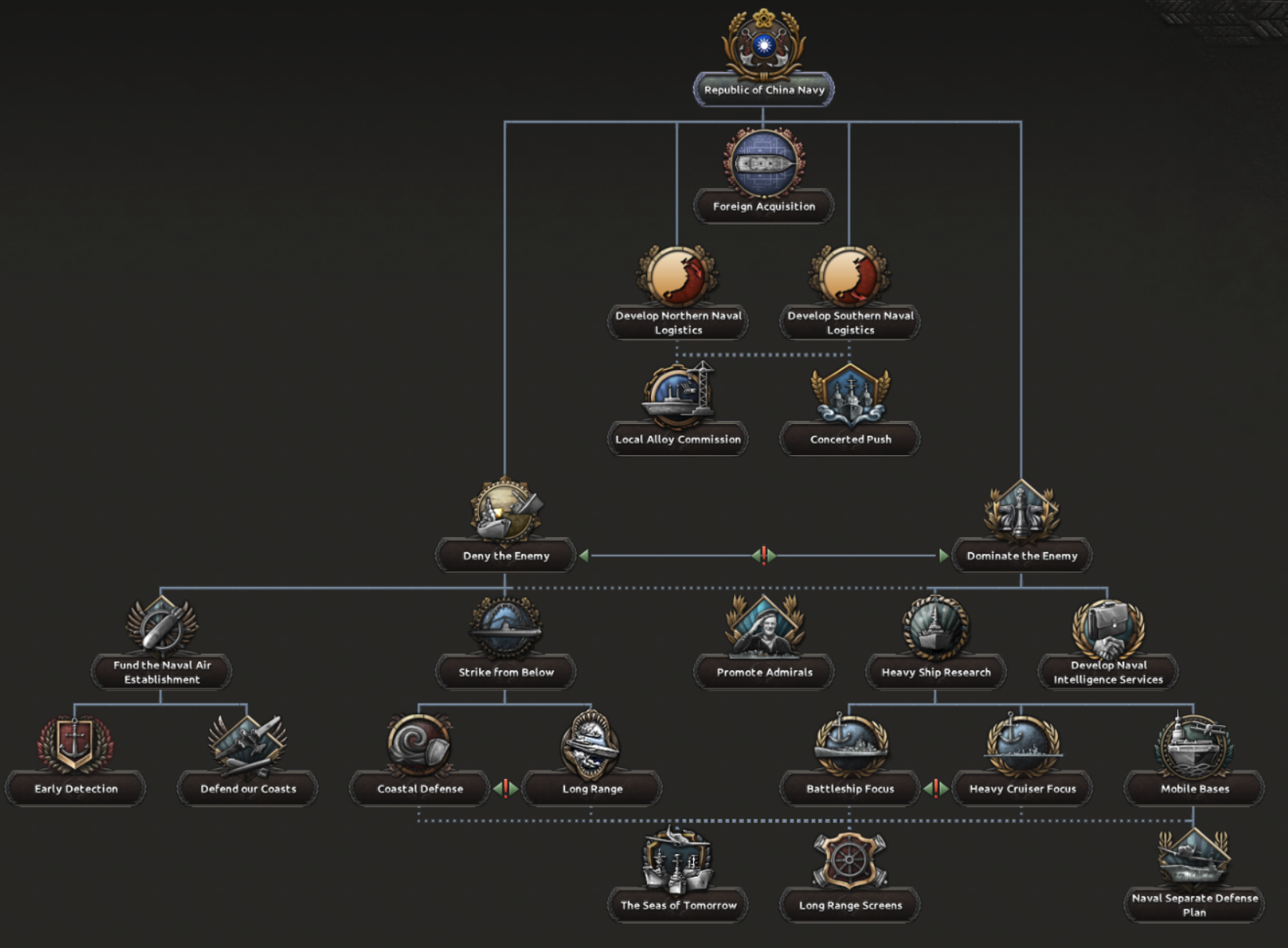 For these reasons we’ve leaned into more what could have been which means that the main option you will have as a player is if you have the need to control the oceans or if your resources would be better spent on denying the enemy the control, because sometimes it’s enough if the enemy doesn’t win.
For these reasons we’ve leaned into more what could have been which means that the main option you will have as a player is if you have the need to control the oceans or if your resources would be better spent on denying the enemy the control, because sometimes it’s enough if the enemy doesn’t win.  For you who likes overviews, here is the tree in its entirety.
For you who likes overviews, here is the tree in its entirety. I hope I’ve been an adequate guide for this quick introduction to the Nationalist update for No Compromise, No Surrender and I’m looking forward to seeing where you bring the KMT revolution. Now I’ll be handing you off to D3vil to give you an update on the state of the Warlords
I hope I’ve been an adequate guide for this quick introduction to the Nationalist update for No Compromise, No Surrender and I’m looking forward to seeing where you bring the KMT revolution. Now I’ll be handing you off to D3vil to give you an update on the state of the Warlords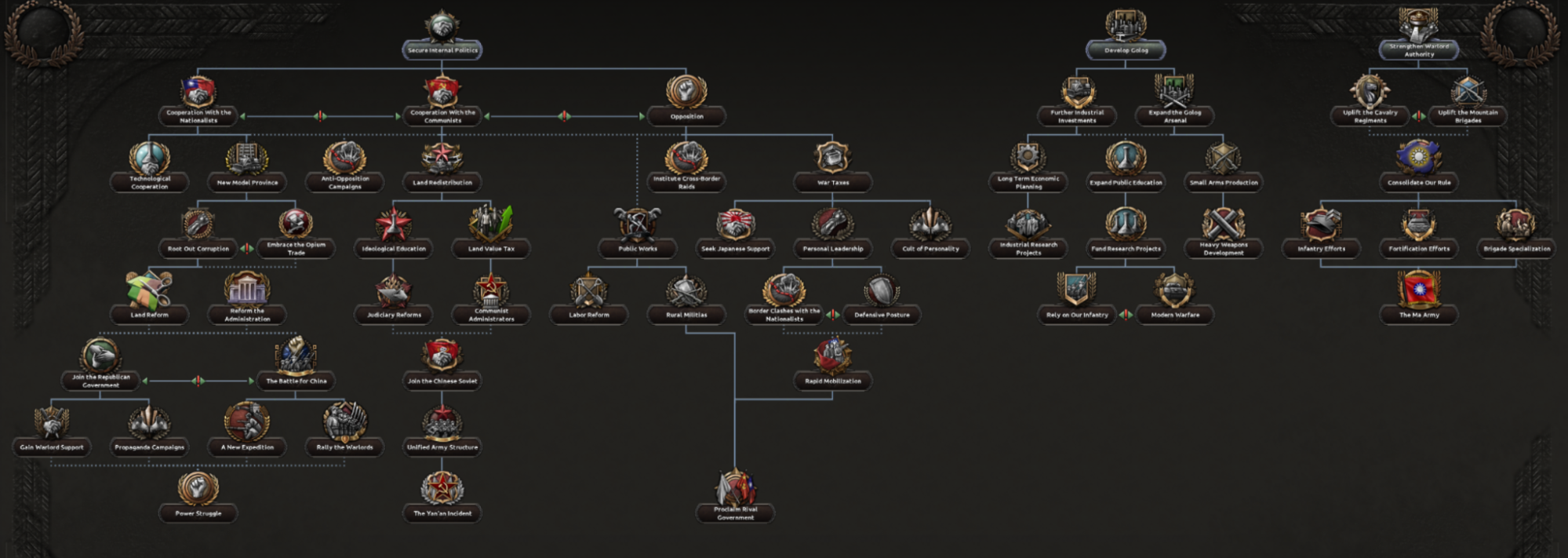 As examples of new sub branches, the Ma Cliques share a subbranch about unifying into one country, while the Sichuan Clique has a subbranch representing the divided administrations and nature of the province at the time, and the Khotan Ma Clique has a subbranch about attempting to unify Sinkiang province under their rule.
As examples of new sub branches, the Ma Cliques share a subbranch about unifying into one country, while the Sichuan Clique has a subbranch representing the divided administrations and nature of the province at the time, and the Khotan Ma Clique has a subbranch about attempting to unify Sinkiang province under their rule. 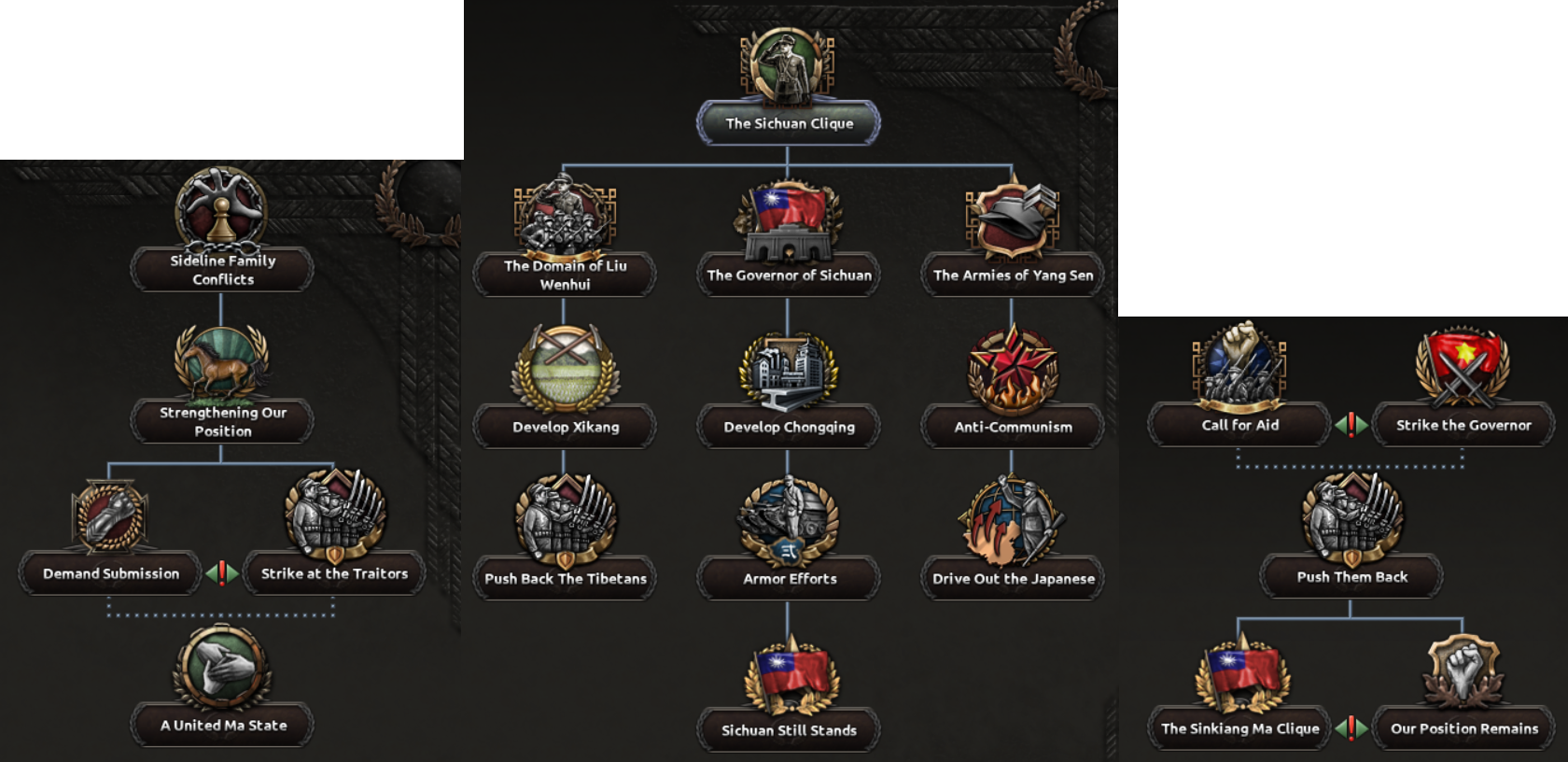 A few of the other warlords have received similar updates.
A few of the other warlords have received similar updates. 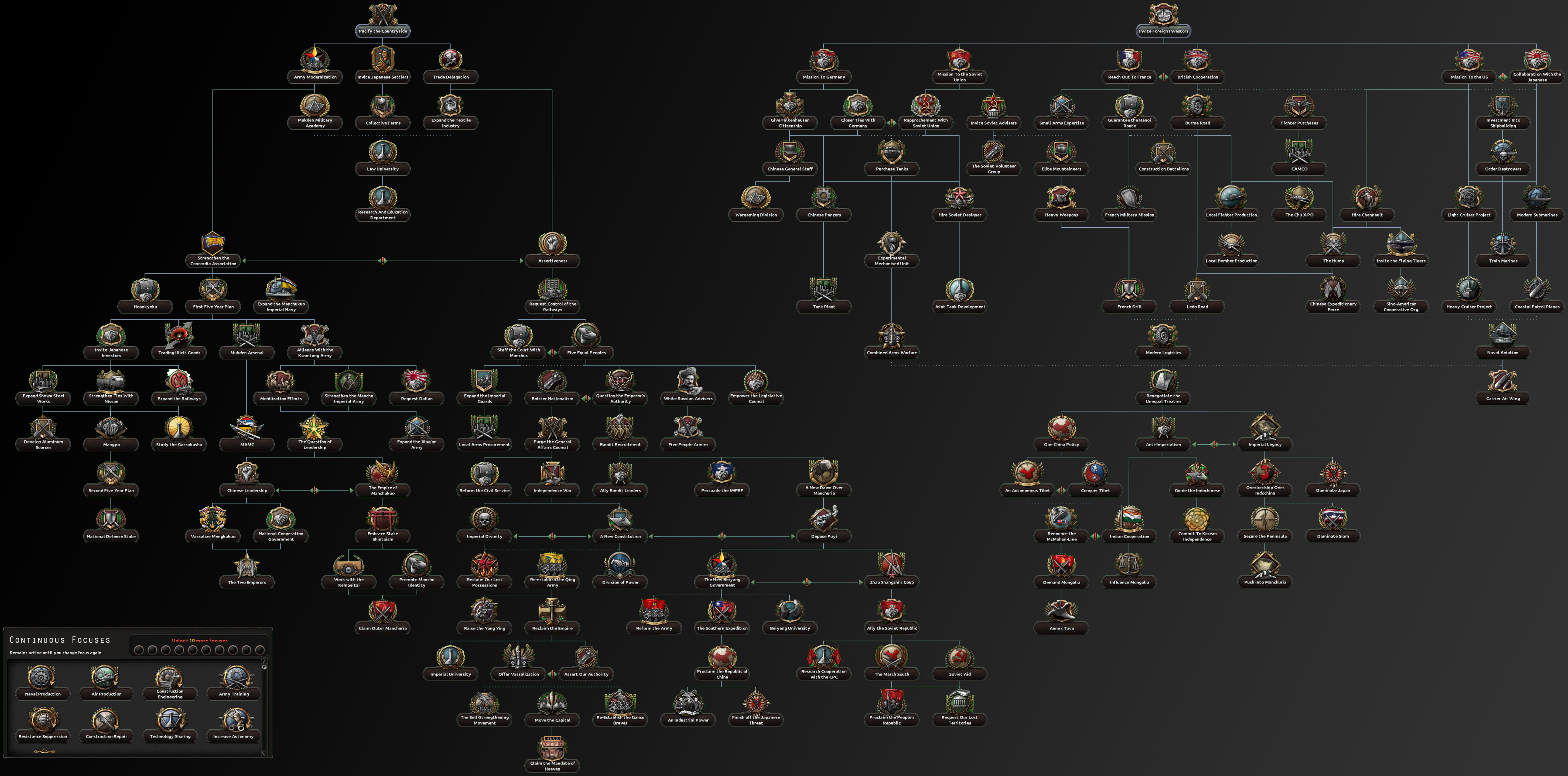 And we added a new Field Marshal and potential country leader for Mongolia :)
And we added a new Field Marshal and potential country leader for Mongolia :) 









 Максимально базированный и полезный гайд на ФЛОТ
Максимально базированный и полезный гайд на ФЛОТ 


 Как ускорить время хой4
Как ускорить время хой4  Как выеб... принудить к миру Грузию за 5 дней?
Как выеб... принудить к миру Грузию за 5 дней?  🏆ЗАХВАТ МИРА ЗА БРАЗИЛИЮ ВЕЛОСИПЕДАМИ🏆ВЫПОЛНЕНИЕ АЧИВКИ
🏆ЗАХВАТ МИРА ЗА БРАЗИЛИЮ ВЕЛОСИПЕДАМИ🏆ВЫПОЛНЕНИЕ АЧИВКИ  Что делать, если вам надоела война?
Что делать, если вам надоела война? 


 Loading
Loading
